Don't wanna be here? Send us removal request.
Text
hello everyone! as you all may or may not know, i had some rather scary diagnoses this year and took some time to process/digest it and work on my health.

i so, so dearly appreciate your patience and plan to post three posts in december: the beauty of ashwini, exploration of the bhratrukaraka across the grahas, and the beauty of uttara phalguni 🧘🏽♀️💓 talk to you soon loves!
xoxo,
angel 💋
95 notes
·
View notes
Text
a brief exploration of the amatyakarakas 🍸

🍸note: any information regarding amatyakaraka placements should be treated lightly, as a good portion of these celebrities do not have verified birth information. i calculated all of the following celebrities with unverified birth times assuming they were born at noon their time!
🍸the amatyakaraka does not share the immense physical focus of the atmakaraka, but serves as the knight (amatyakaraka) to the king (atmakaraka), as it controls much of the labor/work of the chess of life. it is a karaka designed to aid you in picking a field or hobby that can allow you to fully express the passions of your graha. It is the helpful hand that guides you to who you truly are, in this post i focus on the overarching lessons of this placement.
brihaspati amatyakaraka
🌾 aesthetic: the liberation of the femme fatale
🌾 key components: shares similar characteristics to the femme fatale archetype of brihaspati atmakarakas, but inwardly is garnished with the liberated qualities of brihaspati. this is a placement of timing, expansion, and immense growth in the lens of one's work ethic. this is ultimately why these natives are known for their adventurous (and sometime controversial yet successful) business ventures, e.g. kendall jenner's "818" brand and lana del rey's controversies throughout her musical journey, which are centered around intrinsic learning via the external public eye.
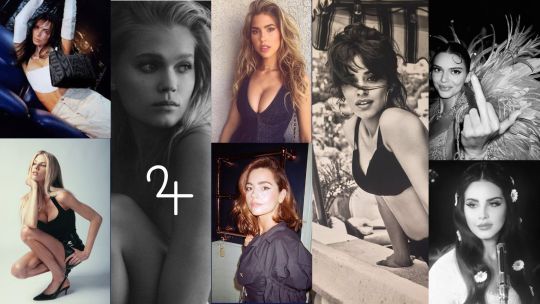
shani amatyakaraka
🪐 aesthetic: the theater of love
🪐 key components: it shares the sensual hollywood starlet aesthetic of shani atmakarakas but this karaka's lesson lies in what they pour themselves into. they excel at possessing the drive and willpower to succeed in their respective fields, but are not without controversy in their private lives. this is emphasized by megan thee stallion's wrongful sh*oting, selena gomez's ex, nicki minaj's infamous husband, julia fox's former partner kanye west, etc.. their incessant focus on their future and work, often leaves much instability in their personal lives outside of their everyday routines.
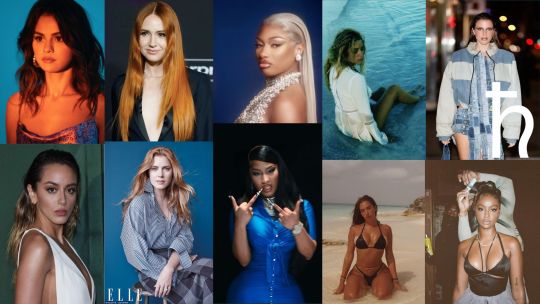
surya amatyakaraka
🌞 aesthetic: the intersection of promiscuity and materialism
🌞 key components: this placement is similar to the materialism noted in surya atmakaraka natives, but is further heightened by this karaka's penchant for promiscuity. this placement's immensely influential nature and general desire to lead/test others can manifest as a form of sex*al temptation of those around them. from professions of acting to involvement in adult industries to modeling, there is a great need to shine their rays onto those around them. the dichotomy agni (the sun) being of purification and knowledge and soma (the moon) being water and nourishment come into play here. the sun wishes to purify and empower those around them through lessons of spiritual teachings. the general focus of the mouth in the photos of surya amatyakarakas is reflective of the mouth being the vessel of soma/the consumer of water. to achieve the purification of agni, you must first be watered spiritually.

kuja amatyakaraka
☄️ aesthetic: the mysticism confidence
☄️ key components: drawing upon the lessons of kuja atmakarakas, a certain confidence is emphasized within this placement. this confidence lies in taking immense risks and undergoing challenging situations for the betterment of your career, talents, and desires. this is evidenced by amber heard's career-challenging court case and jennifer lawrence's recounts and statements about w*instein. this placement is not without its controversy, but it is a placement of willingness to endure immense controversy for personal gain often without the lesson-emphasis of brihaspati amatyakarakas which results in much healing being needed later on.

buddha amatyakaraka
🌑 aesthetic: the ubiquity of feminism
🌑 key components: learning from the misunderstood lalita, this placement emphasizes a certain call to seeking maturation of the self through a higher power and intellectualism. this placement is symbolic of the overt dichotomy of girlhood-womanhood, these natives personify this experience through their accounts of the male gaze, longings for more expansion within themselves, and consuming all the external rays of others for the purpose of bettering and finding themselves (as buddha does to surya).

shukra amatyakaraka
🍓 aesthetic: the languish of luxury
🍓 key components: this placement indicates a certain affinity yet boredom of the luxurious properties of shukra. it causes many celebrities who grow into financial success to possess a coupled, sometimes delayed, distaste of the spotlight/fame. think of selena quintanilla who grew popular with ease compared to her latina musician counterparts but continued to maintain a relatability to the public (similar to cardi b who is still considered "surprisingly relatable" despite being immensely wealthy compared to the general public).

chandra amatyakaraka
🌙 aesthetic: the insatiable pitfalls of revolution
🌙 key components: these women often serve as role models to individuals through their presence in the media, but often serve as a lesson to the pitfalls that come with being "revolutionary". recall alexis ren who revolutionized mid-2010's social media and fashion yet struggled privately with her eating d*sorder. additionally, kaley cuoco was popularized for her role in "the big bang theory" yet too struggled with her eating habits. this is why some vedic astrologers theorize chandra to be associated with eating d*sorders, as yes soma seeks to nourish, but this nourishment (coupled with the drive/talent/profession denoted in the amatyakaraka) results in a potential for restricting soma (nourishment) to feel in control of one's surroundings--that is one's profession or environment.


🍸all of these placements were found using astrotheme/.com and/or astro-charts/.com. it is important to note that some chandra (moon) placements may be off by up to 6 degrees and lagnas (ascendants/rising signs) as well, due to the fact that many websites do not have 100% accurate birth times for the given celebrities.
🍸i am additionally offering readings again for a limited amount of time! if you are interested in a reading, please privately message me. thank you all for all of your patience! please expect the color analysis post soon since it won the poll <3
xoxo,
angel 💋
612 notes
·
View notes
Text
a brief exploration of the atmakarakas 🪻

🩷 note: any information regarding atmakaraka placements should be treated lightly, as a good portion of these celebrities do not have verified birth information. i calculated all of the following celebrities with unverified birth times assuming they were born at noon their time!
brihaspati atmakaraka
🌾 aesthetic: model rockstar girlfriend x guilded glamour
🌾 key components: the femme fatale; the vampy embodiment of s*xuality. expanding on the divine intellect of cyclic and karmic law. "arge-bodied is jupiter, and also tawny haired and eyed, of kapha nature, intelligent and proficient in all shastras"

shani atmakaraka
🪐 aesthetic: the theatrical romantic
🪐 key components: the sensual hollywood starlet. learning how to acquire responsibility and remain afloat during the trials and tribulations of the body, mind, and spirit. "thin and long-bodied is saturn, and yellow-eyed, vata natured, large toothbed, indolent, lame and having coarse hair, o' twice born"

surya atmakaraka
🌞 aesthetic: the golden hour material girl
🌞 key components: of the outshining rays of surya, inspiring the growth in others. the center of the solar system and, thus, the center of attention. called to be the destined authoritative figure they were meant to me by finding humility and calming to their endless desires. "honey-yellow eyed is the sun, square and radiantly pure, o' twice born, of pitta nature, intelligent, masculine, with but little hair, o' twice born"

kuja atmakaraka
☄️ aesthetic: the magnificent mystique
☄️ key components: le féminin indépendant. their brimming beauty attracting vampiric envy from others and, thus, they must learn to set healthy boundaries and protect one's energy. "cruel with red eyes is mars, moving to and fro, of torn form, pitta nature, angry, with a lean medium-sized body, 'twice born"

buddha atmakaraka
🪻 aesthetic: the famed femme feminist
🪻 key components: embodying the misunderstood lalita. the most youthful appearing atmakaraka. fluent in intellect and ever-expanding in knowledge/femininity. "the most excellently formed, of metaphorical speech, and taking pleasure in laughter is mercury, having pitta, having kapha, o' wise, and of vata nature"

shukra atmakaraka
🍓 aesthetic: the renowned, infamous socialite
🍓 key components: the hollywood pin-up. embodying the epitome of venusian luxury and s*xual channeling, but eventually learning to channel their divine intellect away from the temporal/ tangible pursuits of the flesh. "pleasing, lovely formed, the most splendid and beautifully eyed is venus, who is poetical, abounding in kapha, of vata nature and curly haired"

chandra atmakaraka
🌙 aesthetic: the revolutionary (a vessel of subculture in the midst of pop culture)
🌙 key components: of the dark, yin waters of the moon. glimpsing into the realm of the obligatory pilgrimage of the soul. "abounding in vata and kapha and filled with knowing is the moon of round body, o' twice born, auspiciously eyed, of sweet speech, fluctuating and love sick"


🩷 all of these placements were found using astrotheme/.com and/or astro-charts/.com. it is important to note that some chandra (moon) placements may be off by up to 6 degrees and lagnas (ascendants/rising signs) as well, due to the fact that many websites do not have 100% accurate birth times for the given celebrities.
do not worry loves, uttara phlaguni post is on the horizon!
xoxo,
angel 💋
931 notes
·
View notes
Text
victoria's astrological secrets 🫧

🫧 with the recent announcement of the victoria’s secret show and angels resurrecting in december, i decided to examine the placements of the women deemed “most beautiful” and dissect what astrological placements are potential indicators and detractors of this belief. the following graphs i have made used data collected from the available birth information of all 41 victoria’s secret angels. any information regarding house placements should be treated lightly, as a vast amount of the angels do not have verified birth information. the same is applicable for karakas and nakshatras, i calculated both assuming angels with unverified birth charts were born at noon their time!
🪐 atmakarakas of the angels:

🪐 with my recent post on shani’s prevalence in western femininity and beauty, i am sure it comes to no surprise that he was by the far the most prevalent atmakaraka of the angels. as a brief refresher, the atmakaraka is the graha that one relates to the most. it is our innermost self, that is why surya is said to be the natural atmakaraka. shani himself lords over one’s bones, hair, and teeth, all of which—when heightened or emphasized astrologically—bestow its native with abundant beauty. despite shani’s traditional connotations of sorrow and pain, it is also associated with the sense of touch. thus, resulting in its natives’ preferences for fields that require manipulation and emphasis of the physical life form. through sculpting one’s body with the likes of fitness, diet, and self care, these models are able to fulfill the physicality of their shani atmakaraka. additionally, shani is said to bestow hazy, gilded eyes, thin and tall figure, whitened teeth, and an overall ether body (which is overall many of the dominant physical traits of models in the industry). when shani excels here, natives are blessed with the loyalty, frugality, self-control, patience, steadfastness, perseverance, and industriousness required to succeed in the industry of modeling. it is important to note these same qualities are often heightened in the darker contexts of the shani-dominated modeling industry, such as dis*rdered eating patterns and exploitative management. this placement is beautiful for heightening one’s worldly desires of democracy, achievement, and experience, but also results in lessons of the harsh realities of this world, facing loneliness at the zenith of achievement, extreme bouts of fear/doubt, and disappointment. i encourage any natives of this placement to especially look at the house this atmakaraka rules to find what will bring you fulfillment and growth on an individual level (primarily examining its mooltrikona, the area in which grahas feel most at home).
🪐 note that only two of the angels had a shukra atmakaraka, which desires transactional relationships and luxury. this is likely due to this placement being more common in the arts, as it has an innate gift from telling and conveying the stories of art. whereas, shani is gifted in the realm of wearing the art of shukra (serving as his grounding canvas). shani being the servant of the asuras aids him in feeling the most comfortable in shukra’s demanding presence; allowing him to thrive. in a similar way shani atmakarakas thrive when being in the eyes of shukra (the constructive teacher). they take heed to his teachings and internalize them for quick reciprocation and emulation.
🎀 amatyakarakas of the angels:
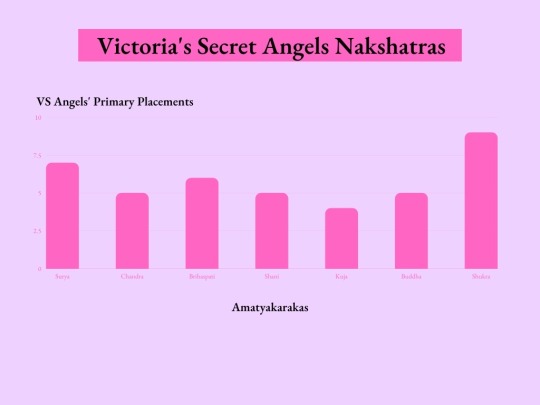
🎀 this reasoning for the lack of shukra serving as an atmakaraka is why i believe it best serves as the most prevalent amatyakaraka. while the results are less statistically significant than those for atmakaraka, shukra is still the most common graha for this placement. think of the amatyakaraka as the second house almost, ruling your career, profession, behavior, karma, and deeds—not necessarily ruling your internal self but how you externalize your atmakaraka. shukra bestows materialistic prosperity, comfortability, wealth acquired through women’s merchandise, and luxuriousness to the fruits of shani. this is why this karaka placement brings forth professionalism in the fields of any inventive, artistic discipline such as fashion without serving as the primary lifestyle of the native. in this way, the natives’ atmakaraka can reduce shukra’s issues with clouded self-perception, heightened sensuality, exaggerated behavior and ideologies, and intense over-romanticism. the restrictive nature of having a shani atmakaraka refines this amorousness and excessive behavioral patterns and, in turn, shukra balances his frugality and conservatism with a healthy pleasure from enjoyment of the touch/physicality he so rules.
🌙 grahas in the first bhava:

🌙 the first house is the realm of one's lagna. this house is considered to be most representative of your existence and true self. the lack of the two most intellect-based grahas, brihaspati and buddha, can give us an insight into the existences of vs angels alike. these grahas' lack of presence is indicating a certain removal from scholarly pursuits and a calling towards the physicalities of the flesh, as seen in rahu and chandra, at an early age. think of the stories of models like adriana lima or candice swanepoel who wanted to serve their communities initially through catholic abstinence and dentistry or dairy and meat farming respectively. instead of continuing to obtain the education and discipline required to succeed in these fields, the models decided to devote themselves to their fashionable craft instead at very young ages. having chandra and rahu in the first bhava can bring self-centricism, sharpening of communicative/professional intellect, and business inclinations. thus, allowing the angels to accumulate success and individuality in the worldly fields of modeling through expertly commodifying themselves.
🌙 grahas in the second bhava:
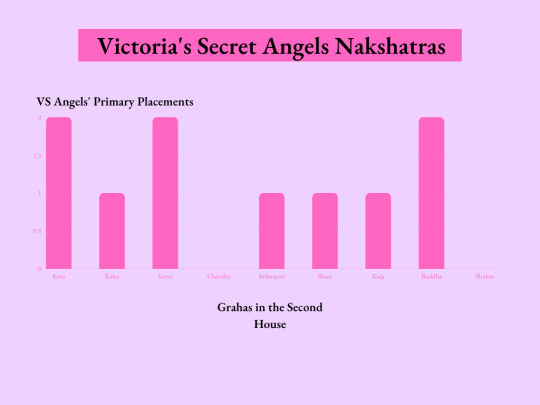
🌙 in a sudden role reversal, we see no models with verified birth times had chandra in their second house. the second house is all about growth and development. chandra or shukra lying in this house is often indicative of requiring materialistic pleasures to ensure emotional satiation. this is why individuals with these placements can truly struggle with financial and emotional fluctuations. contrarily, surya, ketu, and buddha were the most common grahas in the second in the bhava. these grahas lead to excelling in the matters of the second bhava (wealth and possessions) but issues with detachment and grief surrounding one's family. unfortunately, we see this placement manifesting in many of the angels having to leave their families at a young age to model in other countries for months to even a year at a time. this additionally requires a certain dis-attachment from the home (chandra) and comfortability (shukra) to gain worldly knowledge (buddha), authority/grounding (surya), and self wisdom (ketu) in the industry.
🌚 grahas conjunct luminaries (surya and/or chandra):
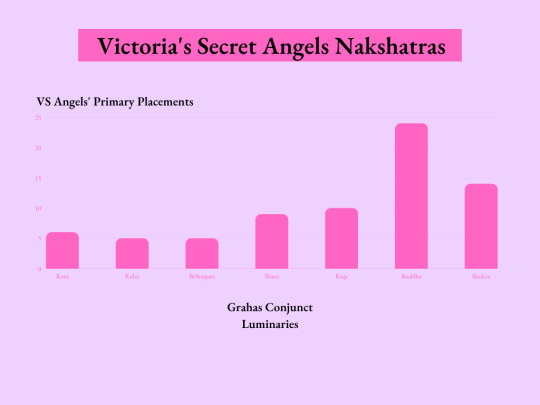
🌚 buddha was overwhelmingly the most prevalent graha to be conjunct the angels' luminaries. approximately 59% of the angels had this placement, meaning 24 of the 41 models. buddha, being the graha of communication, results in a penchant for inquiries, analyses, and wit in conjunction to the undertones of their luminary grahas. essentially natives of the placement excel at marketing themselves: identifying their target audience, knowing their unique selling points (such as creating their signature, inventive catwalks and collaborating with trainers to give onlookers an insight into their workout regime via the "train like an angel" series), clarity, consistency, constancy, and intellectual savvy. buddha's sensual undertones attract customers and a worldwide fanbase of feminine emulation and masculine adoration.
🌚 primary placement (surya, chandra, and lagna) rashis of the angels:
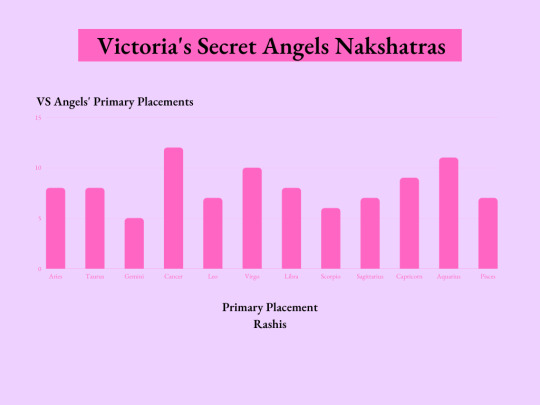
🌚 the cancer rashi was most common in the primary placements of the angels. chandra, the overlord of cancer, aids cancer natives in utilizing their fertile imagination and emotional disposition. due to this, these natives are drawn to artistic expression and emotional retention, exacerbating the canvas-like jobs of the angels in their modeling efforts for the brands' bikini-clad, glamorously unachievable campaigns. while seemingly sentimental, cancers' personalities are said to be extremely changeable, ranging from extreme warmth to secrecy which is often mistaken for hardened coldness. this emotional chameleon-like behavior allows the angels to physically transmute the emotions of their photographer and designer to the consumer/onlooker. however, their need for safety and security allows these natives to sometimes go throughout their entire lives in search for family and the comforts of home (as evidenced by the lack of shukra and chandra placements in their second bhava).
🌚 the second most common rashi is aquarius. who is symbolized by the angel carrying water over humanity and pouring it over the earth. in a similar fashion, aquari nurture their environment by quenching the thirsts of the collective--instilling passion within the masses and motivating them to bring change to one another. this is why this rashi is symbolized by "the star" tarot card. similar to the water-bearing aquarius figure, the star card features a feminine being pouring water into a body of water and into the earth, providing nourishment and restoring hope for the future. she has one foot in the water, symbolizing intuition, and one on land, symbolizing stability. this echoes the same duality in aquarius, which is the only zodiac sign represented by two astrological elements: water for her emotional side and air for her intellectual side. the stars symbolize the card’s overarching message of guidance, hope and inspiration. aquarius pertains to setting oneself apart from others, as illustrated by the large, yellow star on the card. aquarius natives have a strong connection to their own intuition and will listen to that internal voice above all others. which ultimately guides these natives to setting their own trends in fashion: think of the infamous and constant quests for a vs angel body even today. the bird on the card symbolizes the sacred ibis of thought who roosts in the tree of the mind, representing the boundless intellect of aquarius. whether it is improving humanity, inventing the next fashion trend or just bolstering our sense of hope and inspiration, aquarius excels.
🌚 primary placement (surya, chandra, and lagna) rashi lords of the angels:
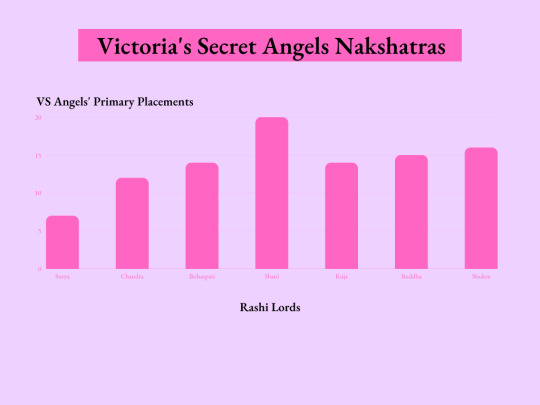
🌚 shani was the most occuring lord of the angels' primary rashis despite cancer's general abundance. think of when shiva came under the influence of shani, he experienced the loss of sati, the first incarnation of his wife. "daksha, the son of brahma, prayed to the mother goddess that she be born as shani's daughter. she agreed on the condition that he would never displease her. he agreed and she was born as sati. when sati matured she fell in love with lord shiva and married him against her father's wishes. daksha disliked this alliance as he felt that the ascetic shiva was not good enough for his daughter. daksha expected shiva to pay obeisance to him but shiva refused to do so, as he was the supreme god and most revered of all. according to vedic tradition, if shiva were to venerate daksha who was lower in stature to the great shiva, the former would be cursed forever. daksha's ego did not allow him to recognize the true shiva. shiva refuses to pay respect to his father-in-law and thereby created an ongoing feud which caused a lot of sorrow to his wife sati.
"daksha decided to avenge this humiliation by organizing a yagya in kankhal near haridwar. he invited all the gods in heaven and prominent men on earth, with the exception of shiva and sati. when sati heard that her father was holding a ceremony, she wanted to go despite not being invited. shiva cautioned her that only misery would result of her going uninvited but she was adamant.
"sati demanded an explanation from daksha as to why she and shiva were not invited. daksha said that shiva, a person who dressed in rags who adorned himself with ashes, skulls and snakes and frequenter of graveyards, had no place in this elite gathering. unable to bear the insult, sati proclaimed that she is giving up her life and in front of an astounded audience she stepped into the sacrificial fire of the yagya.
"when shiva learnt of this, he was inconsolable and in his grief destroyed the yagya and all saksha's army. saksha's head was also cut. then shiva held aloft sati's limp body and began the dance of destruction or tandava nritya. this is the dance that heralds the destruction of the universe.
"guests approached vishnu who was also present at the ceremony. he realized that it was too late to reason with shiva. he let loose his chakra (or disc-like weapon) and cut up sati's body into pieces. the various parts of her body got scattered all over india. wherever a part of sati's body, fell people built a shrine to the goddess shakti. vishnu consoled shiva and requested him to give back life to the dead. shiva did so but insisted that daksha had to be punished for his pride. he cut off a goat's head and attached it to daksha's lifeless body before making him alive. the ceremony was then completed and to this day daksha is depicted with a goat's head
"shani was said to have create all this mayhem in order to punish daksha for his pride and created inconsolable sorrow for shiva. shiva went to mount kailash and lived a life of a recluse and ascetic until parvati (the next incarnation of sati) came into the life and brought him out of the sorrow."
🌚 shani being the destroyer and stripper of maya, it may appear to be an odd placement for such a physically-focused profession. shani basically serves as the personification of spiritual accountability. he was dutiful even when sacrificing his love sati, serving as the emblem of the importance of the sacrificiality of pleasure and needs for greater gain. in a more minute, physical practice, the angels continued to give up what brought them physical comfort: consumption and familial need for the gain of world recognition and beauty. thus, bringing similar acts of concern or judgement from the public (similar to that of shani) due to the past extremism of their efforts to remain in the show and keep their angel status.
☄️ nakshatras (surya, chandra, and lagna) of the angels:

☄️ chitra was the most occurring nakshatra of the angels. think of this nakshatra as the embodiment of succubic understandings. in it, lies the power of evoking female spirits for spiritual purposes. the goddess of its temple is known as bhoom devi. bhoom devi is the personification of all earth/flesh. bhoom devi is the consort of the varaha, an avatar of vishnu. in the satya yuga, "the demon hiranyaksha kidnapped her and hid her in the primordial waters, and vishnu appeared as varaha to rescue her. varaha slew the demon and retrieved the earth from the depths of the ocean, lifting it on his tusks. he restored bhoom devi to her rightful place in the universe, and proceeded to marry her. mangala and narakasura were the sons of varaha and bhoom devi.
"narakasura was the first born of bhoom devi. there are two stories about narakasura's birth: in the first one, he was the first son of bhoomi and varaha. he was born when bhoomi requested varaha for a son. narakasura later performed a penance to receive a boon that only his mother would be able to kill him. in the second story, narakasura's father was hiranyaksha and was born when hiranyaksha's horns touched bhoomi. narakasura is believed to have been the founder of the legendary bhauma dynasty among the boro people.
"sita, the wife of rama, emerged from the earth, and thus bhoomi is her spiritual mother. the story goes that there was once a drought in mithila, the hometown of sita. janaka, the future father of sita, was ploughing the ground. under his plough, he found a baby girl (this girl being sita). raiin showered upon the earth and janaka and his wife, sunaina, decided to adopt sita. as she was born from the earth, she was also known as bhoomija."
☄️ chitra natives mirror the properties of bhoom devi, often struggling with the seemingly never ending attractions between them and draining masculine life forces. while this nakshatra bestows its natives with bursting beauty and abundance, this masculine attention usually begins to sour and darken with time (similar to the trials and tribulations of bhoom devi). while i have spoke about this phenomenon before, i will note that masculine individuals' preference for serving as varaha to that of bhoom devi is directly correlated to the mass masculine adoration we have seen towards the angels in the media. with recent exposures of the toxic happenings behind the scenes of the brand, it is only more evident that chitra natives have been prone to struggling with exploitative behavior. in an attempt to reverse the narrative and make profit from this immense adoration and attraction, we see chitra natives enjoy leaning in to the succubi narrative as they begin to embrace their spiritual awakenings. think of the angels who have recently begun to explore occultism and religion more intensely, such as gisele and adriana. despite their previous strugglings with exploitation, their role in the bhoom devi-varanha dynamic and call to occultism has aided them in their journeys towards healing from the darker undertones of the industry.
☄️ given uttara ashadha's prevalence in the music and fashion industry as a whole, it comes to no surprise that it ranked #2 out of all of the angels' nakshatras. surya is said to uproot poverty, wantonness, malignity and adversity, and procure all those things which are good for current and future generations. thus, its natives are inclined to prosperity in the face of adversity. surya, the cosmic creator’s natural inspiration, is the teacher and ruler of our innate human senses of judgement and discrimination between truth and falsehood and between freedom and responsibility. it is the senses of love and friendship juxtaposed with our rational sense of justice and reason; our passion for progress with our sense of purpose; and direction and destination for life’s values. thus, bestowing great creative wisdom and the brilliant, generous divinities of nature. it separates the good from the great people in this world; removes the sloth, negativity and adversity on this earth; and inspires its natives with enthusiasm for the achievement of dynamic peace and balanced prosperity. forbidding fearsome and ferociousness in one's body, mind and soul and positively transforming the word of divine love and wisdom. in uttara ashadha, he creates fires under the asterism of the final vimshottari nakshatra in his rulership, whosoever should wish that should be offered him: then indeed forthwith; for whatever is offered with the touch of shani (that lies in sagittarius-capricorn), that indeed is given to him. meaning natives of this nakshatra are able to lift their struggles with the aforementioned topics to surya himself to have their wants transmuted into dominance of the earthly realm. these natives greatest longings for spirituality and initial abstinence from bodily superficiality are ultimately what causes them to appear so beautiful and become so successful. in applying the ketuvian principle of abandoning what one initially wants for seeking what the universe knows is right, these natives are granted what it is they so longed for as they sacrificed their initial wants for the promises of surya's delayed gratification.
☄️ it is likely surprising to some that there were no angels (as we currently know of) who possess the bharani nakshatra abundantly. bharani dwells at the very heart of aries. its exaltation place of its nakshatra lord (shukra) lies in the twelfth bhava from it, while debilitation place of its nakshatra lord is in the sixth bhava. since the energy of its nakshatra lord exalts in the twelfth house from itself, it is the nakshatra, which is connected to death, sacrifice, surrender, letting go with the flow, forgiveness and creativity. yet, as its energy debilitates in sixth bhava from itself, bharani natives sometimes have issues with self-restraint, discipline and escapism. which is ultimately why yamaraj becomes its presiding deity, to help these natives integrate surrender and detachment with healthy self-discipline and hard work, which is the domain of yamaraj. think of bharani natives' figures as being the primary subject of arts throughout centuries. yet due to the intense internal reaction it causes amongst others and their immense ability to fixate all attention, it is something that has been hastily and forcefully covered, and correlated with the principle of punishment (the realm of yamaraj).
☄️ remember when krishna states yamaraj punishes sinners, as relayed to vidura (an incarnation of yama) by maitreya during their conversation about the origin and creation of the multiverse: "the brahmanas, the cows and the defenceless creatures are krishna's own body. those whose faculty of judgement has been impaired by their own sin look upon those as distinct from me. they are just like furious serpents, and they are angrily torn apart by the bills of the vulture-like messengers of yamaraja, the superintendent of sinful persons." instead of one's beauty bringing immense adoration to the point of exploitation and celebritization, their beauty brings a religious-like quality reminiscent to the beauty-based punishments of zeus. instead of entertaining the "furious serpents" of the collective for gain, bharanis spiritually castrate them with their meer being.
consider chanting 108 times a unique mantra to surya (on the days it lies in its corresponding nakshatra) and focus on (or worship) the different body part of the body associated with this nakshatra. do exercise extreme caution when doing so and be sure to actively research the pros and cons to this practice and the correct pronunciation and behavior associated with each mantra
while reciting the mantra, visualise the healing rays of surya filling the part of your physical body associated with the nakshatra
doing so will allow you to embrace the energetic properties of the placement!
chitra mantra: om arkaya namah (ankles)
uttara ashadha mantra: om tvashtre saptaturamgamaya namah (navel area)
bharani: om kathoradhamne namah (throat)
☄️ nakshatra vimshottari rulers of the angels:
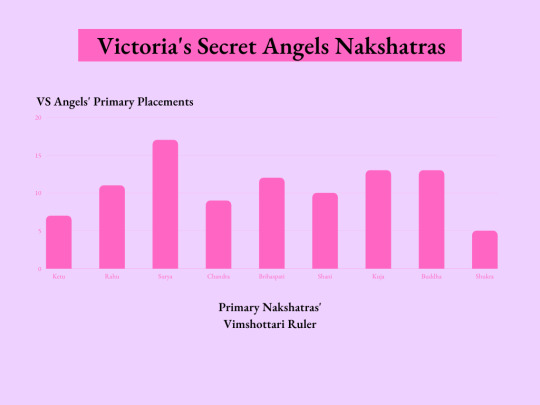
☄️ surya was the most prominent vimshottari ruler and yet again we see shukra being the least prominent of the angels. solar beauty is foundational for all the beauty around us, it rules the carbon that encompasses our surroundings, creates human life, materializes clothes and homes, etc., as surya is the ultimate life force. surya is the illuminator, the creator, the increaser, and master of truth. his rays are supramental activities of revelation, inspiration, intuition, luminous discernment, and they constitute the action of the transcendental principle of perfect knowledge and whole truth. however, these rays also descend into the human mentality and form at its summit the world of luminous intelligence. in a similar fashion, these natives transcend the human mentality and produce innately unique beauty that has never been seen in the industry before. the rays of surya, as they labor to and fro from our mental existence, create three successive worlds of mentality--one superimposed on the other— the sensational, aesthetic and emotional mind,;the pure intellect; and the divine intelligence. the fullness and perfection of these triple worlds of mind exists only in the pure mental plane of being, where they shine above the three heavens, as their three luminosities. but their light descends upon the physical consciousness and affects the corresponding formations in its earthly realms of light.
☄️ surya enlightens the mind and the thoughts in which contain the illuminations of the truth. he is vipra, the illumined. it is he who delivers the individual human mind from the circumscribed consciousness of self and environment and enlarges the limited movement which is imposed on it by its preoccupation with its own individuality. therefore, surya has clear discernment of things in their totality, such as their parts and their relationships to the spiritual plane, and is clear in perception. this is why it is said men as soon as they begin to receive something of this solar illumination, they strive to yoke their whole mentality and embody a conscious existence of the divine surya within them. thus, all of their obscure mental state and all their erring thoughts are manifested in this light so that it may turn the obscurity of the mind into clearness and convert the errors of thought into those truths which they distortedly represent. this yoking becomes the masculine yoga: "they yoke the mind, and they yoke their thoughts, the enlightened, of the enlightened, the large, the clear-perceptioned.” this is ultimately why surya, the lord of knowledge, aligns all creation into their rightful place in "the sacrifice": “knower of phenomena sole he arranges the sacrificial energies.” yet again we see this prominence of sacrificial attitudes surrounding these natives, beckoning their masculine adorers to yoke the impurity in their physicality and heighten their consciousness to experience being near these natives' glorious presence. yes, shukra is undoubtedly beautiful and luxurious in nature, but what is beauty without adoration? what is self care without transmutation into the likes of awakening sexuality/creativity (shukra) into mass attainments and heights (surya)? do let this post serve as good reminder that all grahas, not just shukra, have immense beauty. the physicality of shani, authoritation of surya, emotion reflectivity and conveyance of chandra, sensuality of buddha, mahamaya and business intellectualism of rahu, spiritual refinement of ketu all lead to the overarching beauty witnessed in both the angels and our overall surroundings.
*all of these placements were found using astrotheme/.com and/or astro-charts/.com. it is important to note that some chandra (moon) placements may be off by up to 6 degrees and lagnas (ascendants/rising signs) as well, due to the fact that many websites do not have 100% accurate birth times for the given celebrities.
xoxo, angel 💋
483 notes
·
View notes
Note
Bouncing off of the last post, what is the difference between revati chandra and revati surya?
the difference between your surya, chandra, and lagna - what determines planetary dominance the most (a revati case study) 🎀

🎀 i am so glad you asked this question because it alludes to a larger conversation in astrology: the differences and similarities between the manifestation of the same nakshatra in differing luminaries. you will likely find yourself relating to celebrities or familiar friends who share similar nakshatras or rashis as your top three, but wherein lies the difference between you both?

🎀 you surya is representative of the father, the king, power, authority, your soul, and the way you appear to other people. how bright your outward projection is depends upon the strength of your surya placement. surya controls the vital energy within you that drives you towards attaining fulfillment. whereas, your chandra is representative of the mother, the queen, intrapersonal and interpersonal emotions, mental clarity, familial relationships, and the matters of the mind. it is not inherently your intelligence (as this is under buddha's rulership), but how your emotions shape the expression and drive of your intelligence. additionally, your ascendent is considered the most important house in sidereal astrology, as it rules one's body and personality. do not confuse this with denoting luck, career, and wealth, as these are the more centralized likes of other houses in the chart. in my opinion, it is simply the basis for our being.

🎀 this is ultimately why the lagna is often said to influence one's appearance the most, as it is our core foundation. however, the potency and effectivity of your surya or chandra fluctuates depending on its placement and strength. for example, having a leo uttara phalguni surya in the first house tightly conjunct your lagna that serves as your atmakaraka is more likely to you make solar dominant than having a taurus krittika surya in your twelfth house that is conjunct shani and is your darakaraka. it is all about relativity and strength! this is ultimately why i encourage people to really explore their chart (as there are instances where your big three nakshatra's vimshottari rulers may not be your dominant grahas). look at your karakas, rashis, mahadashas, aspects, lagna lords, yogas, etc..

🎀 rant aside, how people interpret a nakshatra that occupies a chandra or surya is entirely dependent on the previous detailed factors. just remember your surya is the outer self, which can be altered according to your choice and situation while your chandra is the inner you, your true self. surya takes twelve months to traverse all rashis, i.e. remains for a full month within one rashi, therefore, the predictions made can be used for a single month. however, your chandra moves more quickly and is only in a particular sign for approximately two and a half days. Hence, the predictions on the basis of moon sign are more precise and accurate, therefore having a certain nakshatra in your chandra is considered to be generally more significant than your surya (relative planetary strength willing). to see this phenomena, let us examine the differences between different revati surya, chandra, and lagna natives

🎀 above are two revati lagnas, bette midler (left) and shakira (right). both natives look similar to one another with their slightly arched, high brows; almond eyes with a downturned inner corner, prominent nose, oval facial shape, defined cheek apples, and perfectly symmetrical lips. despite both women sharing no prominent placements (shakira is a shravana surya and punarvasu chandra native, midler is an anuradha surya and and swati chandra native), they both are comparable as far as physical facial appearance.
*see my previous post on rahu and shani's, specifically swati and anuradha, correlations to looking alike with other individuals

🎀 anya taylor-joy (left) and carly chaikin (right)
🎀 chaikin has an uttara bhadrapada surya and potential revati chandra. whereas, taylor-joy has an ashwini surya and potential revati chandra. despite both celebrities being potential revati natives, we can see their overall facial characteristic differences. despite them sharing similar nasal structure and facial shape, their eye distance, brow shape, and mouth shape are incredibly different. thus, suggesting that other grahas are influencing their appearance more so than revati.

🎀 paulina porizkova (left) christina moore (right)
🎀 moore is a revati surya and potential ashlesha chandra native. conversely, porizkova is revati surya, pushya chandra, and vishakha lagna native. interestingly, both women have shukra conjunct their surya within a degree. these two natives look more alike than taylor-joy and chaikin despite them having differing primary placement energies. this overall dominance of revati in their appearance (aforementioned lightly arched, high brows; almond eyes with a downturned inner corner, prominent nose, oval facial shape, defined cheek apples, and perfectly symmetrical lips) is likely attributable to their surya being their atmakaraka, meaning the graha most indicative of one's soul in their chart. therefore, it is likely these natives resonate more with their revati surya than other placements in their chart.

🎀 i hope this helped better understand the physical differences witnessed within different nakshatras. i hope to speak about the internal differences in a later post <3
* all of these placements were found using astrotheme/.com and/or astro-charts/.com. it is important to note that some chandra (moon) placements may be off by up to 6 degrees and lagnas (ascendants/rising signs) as well, due to the fact that many websites do not have 100% accurate birth times for the given celebrities.
xoxo, angel 💋
264 notes
·
View notes
Text
the astrological implications of "lookalikes" and nakshatra characteristics - the dualistic nature of rahu and shani🪞

💎 in the seemingly constant conquest for people to find their dominant grahas within their birth chart, it is often helpful for people to compare their morphological features to that of celebrities who share their primary placements. many celebrities often dawn similar faces to their red carpet counterparts which is no coincidence. i have included a few of the ever-increasing physical similarities witnessed among celebrities below and commentaries on what contributes to their facial appearances. this should serve as subtle introduction to a morphology- and fashion-based series i hope to develop within the next year or so. as an additional thank you to the now 5,000 of you, i am also offering 20% off on my cosmetic cosmological readings and vedic reading bundle for the next week. thank you for all of your amazing support and i am beyond excited to witness the growth in people learning about vedic astrology and religion as a whole.

above lies a personal interpretation of mine on the grahas and how they relate to stylistic and morphological essence that i find will be helpful for understanding this post and more posts to come:

🪞 zoë saldana (left) and thandiwe newton (right)
saldana is mrigashira surya (tightly conjunct buddha), pushya lagna (tightly conjunct shukra), and anuradha chandra native. whereas, newton has a swati surya and swati (or vishakha) chandra. the only direct similarity between both women is both were born on monday (the day of the moon) and within their chandra mahadasha which can subtly increase their lunar inclinations.
while both celebrities do not have specific astrological rashis in common, there is a subtle nuance that lies within their astrological compatibility. saldana is extremely dominant in saturnian energies and newton is likely extremely dominant in rahuvian energies. shani and rahu natives are often mistaken for one another due to their similar properties. think of the two grahas as one combined coin of governance over the instances in which define material success in one's life (such as sorrow, pain, grit, and finances). shani acts as the grounded rahu, who is slowed and wise in his pursuit towards fulfillment. whereas, the out-of-body node rahu is exploitative, hasty, and rapid in movement. both govern over the trials and tribulations we may experience in our physicality. thus, both are intricately intertwined and so are their natives.
rahuvian natives share similar features of thinned and highly-arched eyebrows (characteristic of thinner eyebrows being considered more yin in nature), less prominent noses and chins, fuller cheeks, smaller facial frames, expertly defined cupid's bow, and large eyes. whereas, shani natives share similar (if not exact) features to that of rahu but with slightly less exaggerative features erring on the side of angelic essence (yin and ethereal, otherworldly, and mystical) compared to the ingenue essence likes of rahu (decorative, cute yin)

🪞 jaime pressly (left) and margot robbie (right)
another case study of rahuvian-saturnian beauty is pressly (pushya surya loosely conjunct shani and shravana chandra) and robbie (ardra surya tightly conjunct brihaspati, punarvasu lagna tightly conjunct buddha, and swati chandra), both of which share a shani atmakaraka (the graha/karaka most indicative of oneself). both celebrities share the similar characteristics of the two grahas which highly emphasize yin-nature. the subtle essences of both graha types are analyzed below. both of which favor yin and small facial features and clothing details (such as dainty jewelry pieces, note how many of the graha natives sport blue jewelry indicative of shani's rulership) and lighter and softer features (such as bleached/highlighted hair and naturalistic, nude coloring in makeup):
rahu aesthetics: yin, but decorative small-scale yin. features flowing, rounded shapes in both anatomy and clothing-styles. small, compact figure in which natives prefer to adorn themselves with small decorations and details, such as delicate trimmings.
shani aesthetics: most yin essence of the grahas (though it flows back into yang). it is a type of yin that is ethereal in nature. natives' body type has the least concrete shape of all the essences. its silhouettes are long and flowing with draping and webbing. fine textures, as well as transparent and iridescent colours, contribute to their ethereal appearance.

🪞 sarah hyland (left) and mila kunis (right)
hyland has a swati lagna, anuradha surya tightly conjunct shukra, and dhanishta chandra loosely conjunct rahu. kunis has an ashlesha surya, anuradha lagna loosely conjunct ketu and brihaspati, and swati chandra loosely conjunct shani. despite both women being influenced by different planetary aspects (including the oppositionary ketu for kunis), you can notice yet again their saturnian (specifically anuradha) and rahuvian (specifically swati) aspects dominating both women almost entirely.
anuradha: as i spoke about in a previous post on this nakshatra, anuradha natives possess specific, bunny-like features indicative of the nakshatra's rabbit yoni. these natives often possess big, round, and bright eyes; rounded foreheads; full yet smaller horizontal surface area lips; and prominent central incisors.
swati: swati's dominance over mahamaya results in natives' face types having the same length and width dimensions. it is harmonious as a whole without any dominative unique features. they are genetically predisposed to a beautifully attractive round face with harmonic and regular proportions specifically surrounding the contour region of their face. due to the mahamaya emphasis, natives of swati have a distinct affinity for facial feminizing techniques (such as hairline modifications, jaw reduction, rhinoplasty (nose reduction), and facial lifts). note that these improvements might appear the best on these natives due to their rahuvian abundance, but natives must learn to balance this affinity for bodily modification (specifically with their nose or cheekbones) with equal bouts of self care and physical reflection.

🪞 nina dobrev (left) and victoria justice (right)
nina dobrev has an jyeshta lagna, purva ashadha surya loosely conjunct shani, and shravana chandra tightly conjunct buddha. victoria justice has a dhanishta surya, shravana chandra loosely conjunct shani, and swati lagna. both celebrities share similar venusian and saturnian undertones, yet it is likely the shravana emphasis that further adds identical qualities to both women. shravana beauty, contrarily to pushya, it is chandra-based beauty (sensual, deep yin) with saturnian undertones (ethereal yin).
chandra (a graha with emphasis on femininity)-based beauty is mature and sensual when in conjunction with shani (a graha with emphasis on traditionalized values). overall resulting in a romantic-essence beauty type: like the circular shape of a voluptuous, full moon, the romantic shravana silhouette is curvy and round, mirroring that of an hourglass. soft, flowing garments create movement in the silhouette, whereas romantic colors (that of a red and pink palette) look best on these women.
consequently, individuals with the shravana style essence tend to create an overall visual impression of sensuality and glamor. although their essence is yin, such as the ingenue, rahuvian essence, it is a mature sensuality as opposed to the cute, innocent prettiness of rahuvian natives. adjectives such as sexy, 'womanly', and glamorous can be used to describe these natives. abstractly, one can associate the shravana style/anatomical essence with the themes of luxury and indulgence. this aura specifically conjures up images of expensive jewellery, candlelit dinners, and red roses similar to the blooming nature of this nakshatra's artha purushartha and brahma trimurthi.

🪞lili reinhart (left) and brittany murphy (right)
reinhart has an uttara phalguni surya and chandra (loosely conjunct rahu) and swati lagna. whereas, murphy has an ashlesha lagna and swati surya and chandra (loosely conjunct shukra). both women share a surya atmakaraka and brihaspati amatyakaraka. yet again we see a physical example of rahu being indicative of identical similarity amongst others. this is likely due to rahu and shani (if aspecting one's surya or chandra) in one's natal chart being indicative of twins. specifically these aspects include the seventh house and bahuputra yoga. the two grahas' indication of twins can manifest one finding other non-related individuals who share an eerily similar appearance or siblings who are specifically dominant in shani and/or rahu energies looking identical despite not being identical twins. both individuals serving as seperate sides of the same cosmological coin.
also note the stylistic differences between reinhart and murphy above. murphy looks more natural in the shani-based vata colors of silvers and blues. whereas, reinhart looks absolutely gorgeous yet slightly "off" in the neon-red coloring of her dress (due to the countering pitta dosha nature of red). while reinhart may be influenced by the pitta surya via her surya and chandra, it is clear she favors vata coloring naturally. do note that vata dosha colors such as brown and grey should be avoided for those experiencing common vata-associated issues with matters such as anxiety and depression. this is why it is recommended for these natives to incorporate soft, pastel, and pale iterations of the respective colors, such as red or orange. too bright or cold colors can bring natives of this dosha more out of balance. however, white is said to have a good effect on people with a predominant vata dosha constitution. additionally, the accumulated surplus of vata dosha is well influenced by the color yellow (likely contributing to rahu and shani's favoring of blonde hair and highlights).

🪞keira knightley (left) and natalie portman (right)
knightley has an uttara bhadrapada surya (loosely conjunct buddha and shukra) and rohini chandra. portman has a rohini surya, swati lagna, and purva phalguni chandra. both were born on tuesday (the day of kuja). both women incorporate lunar romanticism but differ with their shani and rahu influences ever so slightly.
shani subtlety: a combination of of ying features and mysticism, also known as the ethereal and most yin essence. consequently, individuals with the subtlety of shani tend to create an overall visual impression of softness and otherworldliness or mysticism. although they are more feminine like the rahu and lunar essences, this is an 'old soul' kind of femininity as opposed to sensual or cute, pretty femininity. adjectives such as mysterious, ethereal, mystical, or 'old soul' can be used to describe people under this graha's influence. abstractly, one can associate the graha with the themes of mysticism and the cosmos, often conjuring up images of mythical creatures, fairies and mermaids, and the cosmos and galaxies within others.
rahu subtlety: a combination of femininity with childlike innocence and delicacy, also known as the decorative, small-scale yin subtlety. consequently, individuals with rahu subtlety tend to create an overall visual impression of youthful femininity and innocence. although this subtlety is feminine like the lunar essence, it is a childlike, innocent cuteness as opposed to the mature, sensual femininity of the lunar individual. adjectives like gentle, cute, and pretty could be used to describe natives. abstractly, one can associate rahu subtlety with the themes of innocence and youthful idealism, conjuring up images of delicate flowers.
note both natives have a rectangular-shaped face with square foreheads and jawlines. they have long, ovular faces but with angular edges. they both possess immense symmetry and harmony as seen in lunar women but their vata influences dominate this abundance with facial contouring and structural emphasis. their overall appearance is an example of vata extremism with lunar subtleties. compared to more vata-lunar natives like dobrev and justice, one can really see their morphological differences. additionally, these aforementioned planetary subtleties are also witnessed with both of the actresses careers. for example, knightley stars in more whimsical or vintage films such as "pride and prejudice", "the duchess", and "pirates of the caribbean". whereas, portman stars in more romantic, subtle thrillers that embody the purity complex seen within rahu, such as "black swan", "v for vendetta", and "leon".

🪞 zooey deschanel (left): uttara ashadha surya, chandra, and lagna (tightly conjunct buddha) born on thursday, day of brihaspati, with chandra amatyakaraka
🪞katy perry (right): swati surya and lagna (tightly conjunct buddha) and vishakha chandra (tightly conjunct shani) born on thursday, day of brihaspati, with chandra amatyakaraka
🪐 are you saturn and/or rahu dominant? have you encountered similar instances of being compared to other people or celebrities based on your physical appearance? i think it is interesting that even individuals influenced by these grahas are compared to other people more so than those who are not influenced by shani or rahu. it is likely people would suspect buddha to be involved in this phenomena. however, buddha is not implicative of identical nature, it is implicative of the flattery that lies within mimicry via emulation. this is why mercurial celebrities often undergo bodily alterations to resemble rahuvian/saturnian celebrities (such as bella hadid's cosmetic transformation into resembling carla bruni or the character elvira's direct copying of the character vampira).

🪞 jessica chastain (left) and bryce dallas howard (right)
additional examples of astrological lookalikes:
jessica chastain (anuradha lagna, rohini chandra loosely conjunct brihaspati, and uttara bhadrapada surya loosely conjunct buddha) and bryce dallas howard (revati lagna, shatabhisha surya loosely conjunct kuja and shukra, and uttara ashadha chandra). both share chandra atmakarakas.
jordin sparks (swati chandra, mula surya loosely conjunct shani, and purva ashadha lagna) and america ferrera (ashwini surya tightly conjunct buddha, anuradha chandra tightly conjunct kuja, and purva ashadha lagna tightly conjunct brihaspati)
kiernan shipka (vishakha surya and anuradha chandra) and emma watson (ashwini surya, uttara phalguni lagna, and mula chandra)
* all of these placements were found using astrotheme/.com and/or astro-charts/.com. it is important to note that some chandra (moon) placements may be off by up to 6 degrees and lagnas (ascendants/rising signs) as well, due to the fact that many websites do not have 100% accurate birth times for the given celebrities.
xoxo, angel 💋 (will be uploading part two of my buddha self care exploration soon lovelies)
#vedicastrology#astrology#nakshatras#moon#rahu ketu#mercury planet#budha#saturn#chandra#buddha#twins#identical
556 notes
·
View notes
Text
frivolous or fated: buddha and beauty 🧖🏽♀️🛀🏽

Disclaimer: this is only part one (my document was too long to include in one post). If you would like for me to post part two, please let me know!
🛁 The predominant attitude towards the beauty of things in the classical texts is one of suspicion and met with usual hostility. Physical beauty, especially that of women historically, is accused of causing attachment and craving. Beauty is deemed as “the nutriment for sensual desire” in mercurial principles and thereby being acclaimed as the source of greed, hate, and delusion too. Enjoyment of one’s beauty, and repulsion at another’s ugliness, is deemed as incompatible with the great virtue of equanimity that enjoins us to be mindful and attain enlightenment without the filtering usage of the prism of worldly subjection. Whereas, worldly beauty is demonized, as it is attributed to distracting the masses from the ubiquity of suffering in this earthly plane. This is why in many buddhist principles, the antithesis to beauty-based seduction is focusing oneself upon bringing awareness to the “ugly”, such as death. Yet in countries like Thailand, beauty is theorized to be rewarded to women who have lived without expressing aggression, perpetuating hatred, and experiencing feelings of resentment in a previous life. Focusing on an object such as a disc (or a yantra in vedic culture), is taking in great beauty and bestowing the onlooker with tranquil meditation abundance. In this post, I will be evaluating what true beauty means in various cultures and how we can incorporate these theories into nuanced conversations about self care and overall beautification of oneself. The following deep dive into primarily eastern literature and spiritual concepts does not mean that these are solely accurate opinions, but it is designed to expand one’s palette to spiritual beautification outside of western ideologies.
🛀🏽 There are several modes of beauty. However, the main three categories of beauty I have stumbled upon are inner beauty, wordly beauty, and physical beauty. Inner beauty is the beauty of one’s character, the beauty of the person’s spirit, or moral beauty. But this inner realm or entity is not exactly disjoined from bodily and physical existence. It is simply the beauty that belongs to a person in virtue of their character, moral qualities, understanding, and experience. In contrast with the beauty of things or the world, there is substantial evidence for the importance of inner beauty in Buddhist knowledge. In the Cakkavatti-Shanda sutta, buddha answers his own question, ‘What is beauty for a monk?’, with a list of qualities such as “right conduct, restraint, perfection in habit, and an awareness of danger in the slightest fault”. In the verses of the female ancestors, who repeatedly celebrate their emancipation from the desire to cultivate physical beauty, there is an interesting reference to one nun, Subh, who it is said “went forth full of faith, beautiful by reason of the true doctrine”. In the Abhidhamma, whole sections are devoted to defining the various forms of beautiful consciousness and beautiful mental factors: including compassion, non-delusion and mindfulness (some of which are present in all the beautiful states of consciousness).
🧼 However these references towards beauty have sparked much debate. The word “beauty” is used to talk about “the inner”, about character and virtues. Translators have begged the question why does Buddha not speak of the restrained, alert, right thinking monk as simply being “good” or “holy”? Why is he described as beautiful? And why was Subh deemed beautiful, rather than just virtuous, by reason of dharma? This literature is explicitly stating there is a lack of connection between inner beauty with the beauty of things as seen, heard or otherwise perceived through the ordinary senses, such as sight and hearing. It is, after all, the domain of sensory/what may be perceptually experienced. As children, we learn the use of words like “beautiful” via connecting the term with what is visible, audible or otherwise available to the senses.

🧴 Prominent aesthetic-based philosophers Immanuel Kant (ashwini surya and revati chandra), Alexander Baumgarten (pushya surya and hasta chandra), and Francis Hutcheson (ashlesha surya and uttara bhadrapada chandra) studied the primacy of the sensorial experience by defining beauty in terms of sensory experience. But it has long been recognized that sensorial beauty was a sign of a more elevated form of beauty. For example, Plato, in Phaedrus, states that true beauty is something that one on the earthly plane may only discern when “reminded by the sight of beauty on earth” and that beauty is apprehended through sight: “the keenest of our physical senses”. The journey towards this appreciation of “true beauty” prescribed to Socrates by Diotima in The Symposium, is through witnessing the sight of beautiful figures (bodies). For Kant and others, it was believed that it is the beauty of God that finally matters. As Abbé Suger stated: “the multi-coloured loveliness of gems has… [transported] me from material to immate- rial things, for our dull mind is incapable of rising to the truth except through that which is material”. According to these ideologies, it is in this manner too that one should interpret Suger’s succinct definition of beauty as what pleases through being seen. This is a concept explicitly explored in the rashi of virgo. In my previous notions on virgo nakshatras, I have stated that the journey through this rashi is the journey towards uncovering the jewels of chitra through the eroticism of uttara phalguni and abstinence of hasta, the material cravings of the flesh have become transmuted into the immaterial learnings all virgo natives crave.
🪒 In Buddhist ideologies of beauty, some writers have proposed certain analogies between inner beauty and that of objects of perceptual experience with the intention of justifying their references to inner beauty. For example, a beautiful mind has been compared to a beautiful garden due to neither being considered wild or disorderly. Additionally, similar to carefully crafted art pieces, the beautiful mind possesses balance, proportion, and rhythm. However, unless such analogies are developed and deepened, suspicion about the merely figurative use of beauty will continue to arise. The mind of a man (note this is only in reference to men and not women in this literature) is controlled via craving/delusion and may be disorderly. However, is this “disorder” comparable to that of an untended garden?
🖼️ Some ancient texts argue the causal connections between moral character and physical beauty, with the potential purpose of inviting a transfer of the vocabulary of beauty from the latter to the former. For example, think of the passages mentioned earlier where Buddha describes physical beauty as a future karmic reward for a virtuous life. However, causal connections like this are insufficient to warrant a transfer of terms from physical beauty to its correlation to a person’s character. If references to inner beauty are to be justified, more intimate connections than ones of analogy and cause and effect need to be established between the inner essence of a person and the primary domain of beauty, things as experienced through the ordinary senses. So let us explore further…

🎀 Philosopher Ludwig Wittgenstein (ashwini surya, conjunct buddha to the exact degree, and uttara bhadrapada chandra) once spoke “the human body is the best picture of the human soul”. As a painting may express the feelings of an artist, so too the body, via gesture, comportment, facial expression, or demeanor, is an expression of a person’s inner reality, their character. Inferring only when the inner finds beautiful expression in the body, there is good reason to speak of inner beauty. Similar to when a person’s attitude is described as cheerful due to their cheerful smile and physical gestures that convey it to other people. In this case, the beautiful soul is “beautiful” because its bodily expression in the world is beautiful. Expression, therefore, is a kind of intimate connection required between the inner and the outer. The virtuous mind and/or character is only beautiful because it finds beautiful expression in and through the body. The idea that virtue, like courage, finds bodily expression is no more difficult and controversial than the idea of bodily expression of feelings, i.e. cheerfulness and sadness. A gesture, for example, is an expression of anger or courage when it is itself angry or courageous, and in a way that presents itself as having such a quality, at least to the mindful observer. So why should virtue find expression in beautiful gestures? Is this a matter of luck?
🧧 This connection is not at all a matter of luck. Beauty that is expressed bodily is the expression of virtue. We recognize and appreciate gestures, facial expressions and so on as beautiful precisely because we experience them as expressions of virtue. A woman’s smile, for example, is found to be beautiful because it is seen to express compassion. A monk’s comportment is deemed to be beautiful because it is experienced as an expression of humility. It may perhaps be that this expression of compassion or humility is faux. But that does not negate from the fact that our reasoning for finding the smile or comportment beautiful is the perception of it as an expression of virtue. Behavior that expresses anger may be feigned, that does not mean that the connection between angry behavior and an angry mood is merely contingent. Nor is the connection between beauty of expression and virtue. This is why bodily altercations for the purpose of increasing one’s beauty is not necessarily warranted for demonization.
🪭 This virtue-based attitude toward bodily beauty was personified by the words of Kant. Kant argues beauty belongs to the human body due to the body’s manifestation of moral virtues. There are similarities to this virtue emphasis in Buddhist texts too. For example, it is implied that it is appropriate to call Subh “beautiful by reason of dharma” because of the ways her holiness is manifested in her personal cleanliness and calm/grace of her comportment. Some testaments to Buddha’s physical beauty are centered around his sexual attractiveness to women who are “overpowered by passion” in his presence. Therefore, it is true that sometimes Buddha is found to be physically beautiful, even by people deemed to possess pure minds, as gentle dispositions are casual for other virtues such as fine countenance and posture to manifest. According to canonical texts, nearly all of which make for masculine physical beauty, include “the torso of a lion” and “straight limbs” of which are aspects of the Buddha’s comportment, such as effortless grace of movement, cleanliness, and calm that are expressions of his virtue. It is not only in Pali and Sanskrit literature that there is evidence of a virtue-based understanding of bodily beauty. In eastern asian Buddhist writings, there are similar understandings and underlying connections. For example, beauty is not merely of appearance, but of the spirit (suggesting both are intertwined). It is this inner quality that possesses beauty precisely because of the way it manifests itself outwards via grand gestures, glances and poise. Thus implying there is no warrant for referring to inner beauty as beautiful unless this beauty is expressed in and through the body.

📿 For a person’s character or inner reality to qualify as beautiful, it must possess magnetism. It must attract the heart. Whether this magnetism or attraction is thought of as a further condition of inner beauty, in addition to bodily expression, or as an aspect of this expression that deserves to be made salient in an account of inner beauty is up to one’s personal spiritual journey. Either way, it is through the body that a person exercises magnetism and attracts the hearts/adoration of others. This beauty must be magnetic and attractive via exerting radiance that draws people to it, is an idea found in the teachings of Plato, Plotinus and a minority of later Christian thinkers such as the pseudo-dionysius. It is this magnetism that distinguishes the beautiful from the good. Certain states of a person can be considered “beautiful” and this is due to the person who exemplifies such beauty embodying or mediating a certain concentration of energy. This energy sustains a certain demeanor and perspective and through this radiation and attraction. It is an energy that is aptly described as an object or form of eros (erotic love). For a person to count as beautiful, it is not enough that their virtue shows up in some way, such as solely via donations that one makes to charities or volunteer work. It must show up in an aesthetically charged way: via gestures, demeanor, style, and presence that draws others, sensitive to the energy being radiated, to the person. For just as there was recognition that inner beauty must be bodily expressed, so there is an acknowledgement in some Buddhist texts that inner beauty must attract.
🔮 Consider once more the texts that attest to Buddha’s personal beauty. Gotama was said to become radiant in the presence of Buddha’s beauty and seeing him there, standing in his beauty, men and women are drawn to devote themselves and offer reverence to him (similar to the powerful mahavidyas discussed in the vedic religion). Contrarily, consider the sequence of verses in the Dhammapada in which the search for perfection is compared to a bee’s search for a beautifully scented flower. In order to possess beauty, the words and actions of one must exude a perfume that attracts others. This perfume of virtue, one verse tells us, “gives joy to the soul”, as the light of wisdom is emitted by a truly enlightened follower of dharma. So too inner beauty exerts the same magnetism on the searcher for perfection as a flower’s scent attracts a bee. This theme of beauty’s magnetism is a persistent one. In the thirteenth century, Dogen observed that the body of a true follower of Buddhism feels at ease and “their actions take on grace”, so that this person’s “appearance attracts others”. In this text, Dogen is drawing upon not only Buddhist principles, but a Daoist and Confucian tradition in which the de (‘virtue’) of “the consummate person” or sage is conceived of in terms of charisma, of an inner goodness that is at power to influence and attract others.

🪔 Beauty’s magnetism is attested to by contemporary Buddhists as well. In “Attracting the Heart”, Samuels examines the aesthetics of the emotions in present day Sri Lankan religious life. Samuels’ research provides a source of Buddhist testimonies, mainly from monks and novices, in relation to the magnetic power of moral beauty. For example, he speaks of how they attempt to go beautifully in order to attract the people’s hearts via their dignified posture, speech, or cleanliness. Stating a monk must be “beautiful to the eye” or to the ear, when reciting verses in order make people feel longing for “the holy life”. As Samuels states, his research confirms that there is value in an aesthetic standard that informs Buddhist practice and invests into a quality of bodily movement, posture, speech, and action. Thus, inducing an aesthetically pleasing transformation. This attempted to justify the notion of inner beauty that several authors attribute to Buddhist thinking. Such a justification is at least intimated in Buddhist texts and testimony. Thus, virtue, in order to constitute beauty of character, must be beautifully expressed in and through the body, in a way moreover that exerts magnetism or attraction. Later on, I explore the possibility that a distinctively Buddhist understanding of beauty in art may be inspired by the Buddhist understanding of inner beauty. Earlier, I spoke of the assertion that awakened experience is an experience of beauty, but it may be right to suggest, immediately afterwards, that through the awareness sought by Buddhists, our appreciation of the arts is also enriched. If this is true, however, it will solely be attributed to the beauty appreciated in art as it is intimately related to the inner beauty previously discussed.

🧘🏽♀️ For some Buddhists, the most contrary feature to the religion of the ordinary discourse of beauty is its discrimination, on the basis of subjective experience, between beautiful and non-beautiful things. The “beauty” that simply stands opposed to ugliness is not true beauty… but deemed to be rather a dualistic idea according to Yanagi Soetsu (uttara bhadrapada surya and swati chandra). True beauty, Soetsu describes, is a state of mind, of “freedom from impediment and preoccupation”. For someone who achieves this state of mind, “everything is beautiful”, includ- ing all works of art. These remarks attempt to relate beauty in the world to an inner, ‘true’ beauty of the mind but not without nuance. Yanagi himself makes the very distinctions between beautiful and vulgar (or graceful and garish) artworks which can be contradictory. Whether or not an intelligible concept of beauty, according to which everything is beautiful, can be developed, it is clear that this would not be the ordinary, central concept of beauty. To be told that, in the Buddhist understanding of ‘true beauty’, all art is beautiful is, in effect, to be told that Buddhism has nothing to contribute to the aesthetics of beauty in art.
🎨 The challenge is to work outwards towards a notion of beauty in the world and in art, one that is compatible with discernment between the beautiful and the non-beautiful, from the notion of inner beauty previously spoken about. We have encountered, in effect, a clear-cut, paradigmatic, case of worldly beauty–in the gesture, demeanor, comportment or whatever bestows a beautiful expression to virtue of character, and thereby justifies reference to inner beauty. The body and its actions are in and of the world, their beauty is, in this sense at least, worldly beauty. Crucially, we have also encountered a case where beauty of bodily expression is at the same time a case of beauty in art. Zeami’s view that a certain kind of inner beauty manifests itself outwards in the gestures, glances and poise of an individual. But this individual is an actor, whose beautiful bodily expression therefore belongs to an art form. More generally, in an appropriate context bodily movements and activity may constitute artistic performance, such as a dance. In such contexts, there is no difficulty in seeing that art inherits, via the bodily activity that constitutes it, the inner beauty that it expresses.
🪻 This concept may be applicable to other arts and practices, including many of those that, in East Asia, are called “ways" (Japanese do, as in judo). Not all of these – swordsmanship, for example, or calligraphy (shodo), or the way of tea (chado) – are accepted by the standard Western connotations of ‘the arts’, and certainly not of ‘the fine arts’. But, in Asia, a distinction between arts and crafts, and between these and various other do, is not a definite one. Indeed, it is regarded as an artificial and potentially misleading dualism. Arts or ‘ways’ such as archery, the tea ceremony and gardening differ from dance and mime, typically, in having a practical purpose, such as hitting a target, making tea or creating a garden. That is one reason why these arts require the use of ‘instruments’--a sword, a tea whisk, a hoe–as well as bodily movement. But it is not unnatural to regard these instruments as extensions of the body, as specifically honorary parts of the body. For in none of these practices is the instrument deemed to be a mere tool, to be used in a way dictated solely by a goal. These instruments are to be used with respect and, like one’s hands, with expression. The gardener or tea master is not just clearing away weeds or brewing up a nice cup of tea. They are engaged in a practice that bodies forth the virtues, including compassion, humility, mindfulness, and friendship. In effect, they are concerned with practicing an art or following a way in a beautiful style. Like Zeami’s actor or a dancer in a Buddhist temple, the gardener and tea master via their own and their extended, ‘honorary’ body seek for beautiful physical expression of an inner beauty.

🎭 Many of the Buddhist-inspired arts or ways, the sharp distinction familiar in Western discourse between practice and product, between artistry and artwork, is rejected. It may be an exaggeration to say that, for gardeners, caring for the garden is not a chore, but the very point of having a garden in the first place. But it not only conveys that gardening is not a mere means to an end, the garden itself, but it is a place that depends on a gardener’s continuing care, the garden is not a finished product distinct from the practice of making and maintaining it. To focus, therefore, on the beauty of a practice is not, in the case of many ‘ways’, to ignore the beauty of something, the work, that is separable from the practice. Additionally, even when a distinction is made between a bodily action and its artistic product, many Buddhist artists would refuse to accept that aesthetic attention should exclusively, or even primarily, be devoted to the latter. It is easy enough, of course, to distinguish a calligrapher’s action in drawing with a brush and ink from the characters that are the result of this action. But when it is said of Kobara Sensei, that he and his art “had become one”, the point is to emphasize that the products of an individual’s art are not to be appreciated in isolation from admiration for the individual themself, for the virtues, like kindness, enable their works to look the way they do.
🩰 Kobara’s virtue, his inner beauty, enables his works to look as they do in and through the bodily movements, the physical style, that at once express it and create the characters on the paper. This is an example of the general way in which, for Buddhists, artworks inherit the inner beauty of the people who make them. By giving a sense of the beautiful bodily engagement through which they came into existence, the works themselves body forth the inner beauty of the virtues. Interestingly in twentieth-century Western art criticism, there also developed an appreciation of works as expressive of the bodily activity responsible for them. A significant aspect, for example, of people’s enjoyment of works by Van Gogh, Rodin and Pollock is the palpable sense these works require a certain strength and energy that went into their making. The difference between this occurrence in Western art appreciation and the more abiding Asian tradition is the concern in the latter for the moral beauty that is expressed in an artist’s bodily practice. By extending to art the idea of the body as being beautiful in and through its magnetic expression of inner beauty, it is possible, then, to endorse Batchelor’s beliefs that Buddhism is not just inner experiences. It is known through buildings, gardens, sculptures, paintings, calligraphy, poetry and craftwork’ and “present in” the marks and gestures of artists and artisans.

💋 Please do let me know if I should post the second installment of this document! I have been candid to some about my current health struggles and taking a leave of absence from ballet. I am so incredibly touched with everyone’s kind words and appreciate the amount of kindness i have been met with during these vulnerable moments. I love each and everyone of you and am deeply praying for your successes and triumphs. While I spoke of Buddhism in this post, I will talk about Buddha (mercury) and certain nakshatras correlated to this theory soon…
xoxo,
angel 💋
201 notes
·
View notes
Text
the femininity of shani (what we can learn from pushya) 🌷

🌷 monica bellucci: pushya chandra
🌫️ The mystical tundra of Shani is often overlooked by its restricting feminine complexity and misconstrued for the nature of Buddha (the tantalizing serpent of Ashlesha). While their indirect submissive natures are similar in comparison, it is often natives of Mercury who use this explicit behavioral pattern for more materialistic, perhaps conniving, matters at hand. In this exploration of Shani’s ancient connection to divine femininity, I want to purposefully disclose that their submissive, seemingly “neutral” expressions are not the same. Buddha is the snake of binding to the collective for the intent of freedom and entangling or ensnaring their victim for the purpose of disempowering. Shani is the snake of binding to the contemporary nature of society for the intent of cooling the darkness of ego and empowering the higher collective. Buddha bestows the intelligence of the material aspects of the subversion into the intellect of worldly matters. However, Shani is the intelligence of the occult undertones which control the very essence of the material plane and the union of what is to come after we conquer the very shadows of the tenth house (the rashi of capricorn who will be the awakening of the realm, once we are released from Kali Yuga) to the hidden truths of the eleventh house, the supposed house of personal ties and fulfillment.

🌷 jessica lange: pushya lagna
☔️ There is a specific air of mystery around Shani and the graha’s corresponding nakshatras, bhavas and rashis. Much of the information provided is rather repetitively regurgitated from varying sources and of surface nature. My goal with this exploration is not to specifically delve in the expressional aspects of Shani, but to focus on the graha’s distinct involvement in the path of divine femininity. My hope is this exploration will awaken the serpent of knowledge within you, to explore the more niche archetypes within the vata umbrella that is Saturn.

🌷 miranda kerr: pushya lagna
⛩️ Vata dosha is most synonymous with cold, bereaved individuals who search this earthly plane longing for sustenance. It is the cold hands that seek to grasp the tangibility of spiritual words, it is the homeless widow who was once filled with wanderlust now bereaved, it is the drowsy feeling that surmounts when you look upon the rain beating down on your window pane. It is the dosha characteristic of the feelings we most disdain and wish to shy away from and simultaneously the realm of Shani, Chandra, and Rahu. We have heard the tales of the greedy, insatiable spirit of Rahu; the forgetful, lusting of Chandra; and the forever dried and cold spirit of Shani. Having repeatedly heard the rhetoric of these respective deities, a certain air of weariness has surrounded them respectfully. But you must continue to remind yourself of the necessity of attaining equilibrium and leaning into each graha’s meanings, teachings, and significances. If you are dominant in either of these vata grahas, know that you are more than the sterile or greedy archetype that has been placed upon you, as Kali (Shani) was equally as ferocious as she was creationist, Chhinnamasta (Rahu) was equally as violent as she was self-sacrificing, and Bhuvaneshvari (Chandra) is equally as intimidating as she is the supreme being of the earth, atmosphere, and heavens.

🌷 paris hilton: pushya chandra
🩸 In a similar fashion, the ethereal air of vata is equally as destructive as it is light, cool and dry. It governs all movement and processes in your mind and body (such as blood flow, breathing, and the coagulation of thoughts in your mind). This rulership of movement is why Shani is so astute and articulate within the realm of femininity. Shani is able to manipulate the vata element to attract and constrict around those we long to unite with. These elements of constriction are often associated with Ashlesha/Buddha, but significantly vary from each other.

🌷 gisele bundchen: pushya surya
🐍 Think of the Pushya nakshatra, the “Kula” star, resembling the flower of the snake gourd. Similar to Ashlesha, Pushya is also associated with serpentine movement. It is the maternal snake before it enters the stage of selfishness. It is focused on laying its cosmological eggs, whereas Ashlesha is the mother after this stage that abandons the cosmic eggs of Brihaspati (carefully crafted in Punarvasu) to never return or protect her young again. Ashlesha is leering into the gandanta knot spirituality of disempowering the collective, coiling up to rest in preparation for the spiritual shedding that awaits in Magha. Pushya is leering into the birthing of the collective itself. With the knowledge of vata dosha, Pushya is able to tap into previous experiences of destruction and coldness to relate to others. Using those previous experiences to further divulge into the mystified unknown that often longs to be hidden.

🌷 kate moss: pushya lagna
💒 This is why the cancer rashi is essential for developing cosmic energy and harnessing/wielding it. The cancer rashi is ruled by Chandra, of which is correlated to the Kamala Mahavidya (the vata being whose symbolism is comparable to that of Aphrodite or the Christian Mary). The primary “devastating” nature of vata is what sprouts fertility and purity, as the dirtiest mud will produce the freshest lotus. It is recommended in order to celebrate her, devotees engage in eating spicy, hot foods, as they ignite passion. These spices may include cinnamon, garlic, saffron, or chili peppers due to heavily spiced foods having the ability to bear this Mahavidya’s luscious energy. These same foods are associated with the vata Shani, in a similar fashion, Shani and Chandra are considered enemies but respectfully hold the cosmic keys to one another through the likes of Pushya and Shravana. The metaphor for the consumption of extreme vata spices that one earns the ability to celebrate and veneer the Mahavidya in her idealistic form is comparable to the narrative of sacrifice one must engage in to witness beauty (spiritually and physically). Aphrodite was offered sacrificial doves (bird’s being Shani’s primary vahana: vehicle) and smoky incense (smoke being ether in nature which is of vata dosha) in an attempt to receive love, fertility, and union. Whereas, the Virgin Mary was deemed pure due to her great sacrifice when she offered up the life of her Divine Son Jesus using her “Immaculate Heart” (similar to Kamala’s abundance in the anahata/heart chakra). In “A Prayer of Praise to the Blessed Virgin Mary” by St. Ephrem, he sang: “….Thou indeed art our only hope, most sure and sacred in God's sight, to whom be honor and glory, majesty and dominion, for ever and ever, world without end. Amen.”. Similar to Kamala, Aphrodite, and the Virgin Mary, so too must the masses work to earn the right to witness Shani’s femininity due to its premiere selectivity. This is why Pushya births the highest grossing models and revolutionary actresses in history [e.g. Halle Berry, Twiggy, Marlene Dietrich, Selena Gomez (who is now the most followed woman on Instagram) etc.], as the masses find pleasure in working to witness the mysticism vata bestows.

🌷 selena gomez: pushya surya and lagna
🍷 This mysticism is often deemed “odd”, “exotic” or “unique” and this is exactly where we can learn from the Mahavidya Kali. The darkened Mahavidya Kali breaks conventional stereotypes of feminine beauty and sexuality in Hindu goddess mythology. She serves as the dominant sexual partner straddling the prone Shiva (the master of poison and medicine, the great yogi, overlord of time, the cosmic dancer) and the wild warrior goddess drinking demon blood. She is originally depicted as a symbol of uncontrolled fury emerging from the fair, beautiful goddess Ambika (goddess of supreme power, energy and invincibility), in the battle with the demons in older Vedic texts. Thereafter, she gains independent existence both as the dark, mysterious and sexually demanding version of the more benign and auspicious Parvati and the primordial goddess power pre-dating the Hindu trinity of male gods, the Universal Mother Force which embraces both good and evil, gods and demons in the Kalika Purana. Unlike other texts which emphasize Kali's role in the battle against the demons, the Kalika Purana's focus is on her sexuality and her darkly sensual beauty. Equally it is on the heterodoxical rituals associated with her worship involving blood and flesh offerings, wine and the use of sexual intercourse as opposed to Vedic rituals.

🌷 dakota fanning: pushya chandra
❤️🔥 In Kalika Purana, Daksha’s daughter Sati, born fair, assumes the fearful visage of Kali and the other Mahavidyas to terrify Shiva into submission. At Daksha’s yagna, her father attributes her dark color to constant proximity to the wild-mendicant Shiva, causing her to give up her life in sorrow and humiliation. In the second portion of the Purana, she takes the dark and beautiful form of Parvati, similar to the appearance of a blue lotus. She was born to serve the gods’ purpose of luring into domesticity the stern, austere hermit-like Shiva to preserve the cosmic cycles of creation, preservation and destruction. It is only later, piqued and jealous of Shiva’s propensity towards fair-skinned goddesses that she emerges from her kosa (sheath) of darkness to become the golden-hued Gauri. Yet her darkly alluring and compelling sexuality is highlighted in the text as opposed to the prototype of a domesticated wife and mother like Candi in the Candi Mangal Kavya. John Stratton Hawley in his Prologue to “Devi: Goddesses of India”, noted that Kali in a strange way mediates between the transcendent goddess, the generic Devi who has supremacy over all forms of life and the consort goddesses like Lakshmi and Radha. Hawley wrote: “On the one hand, Kali unquestionably manifests herself as supreme—whether as a mother demanding submission or as an uncanny, uncontrollable force—but on the other hand, her supremacy is paradigmatically measured by the power she exerts over her consort the great god Shiva”. He detailed an example of her sexual dominance, the iconic representation of Kali dancing wildly on the prone, ithyphallic corpse of her husband Shiva. The Kalika Purana initially projects her as the manifestation of the universality of divine femininity, Mahamaya, who is Visnumaya and Rudrani consort of both Visnu and Rudra (Shiva). She is Savitri, Saraswati, through the power of her maya (illusion), incomprehensible to all who are ensnared in her power of illusion. She is Visnu’s Yoganidra, his state of cosmic sleep or stasis. She is Yogamaya/Mahamaya, who ensnares the cosmos in her web of illusion, she is Mahamoha, the fatal enchantress and the Supreme Trinity itself is not immune to her mysterious lure. Another goddess text, the Sri Lalita Sahasranama calls her Mahabhoga and Bhogini implying her rajasik-rupa (dynamism, also material grandeur) of being steeped in worldly luxuries. Yet she is the path to mukti (salvation) for beings trapped in the worldly and materialistic which is all part of her cosmic illusion. The Sri Lalita Sahasranama also states that she is Mohanasini, destroying the moha (bondage) of her devotees and Pasu-pasa-vimocini, releasing them from the inferior, coarser earthly bonds. She is Vidya (knowledge) for the householder who desires mukti (salvation), and Avidya (ignorance) who binds the universe in bonds of material desire. She is the primeval Demi-Urge, the Adyasakti that activates the inert maleness of Shiva into the dynamism of the Shiva-Sakti or Purusa-Prakrti union for without Sakti, Shiva is but a sava (corpse). Among the Sakta devotees it is Kali amongst the many manifestations of the divine feminine who is recognized as the Adya-murti, the original goddess manifestation. In the text, Kali alone can awaken the virility within Shiva, for on the one hand, she is a yogin to participate in his yoga and on the other, it is her eroticism, wild and uncontrolled, which is the perfect counterpart to his dominant sexual urges.

🌷 marlene dietrich: pushya chandra
🦶 Kali is feared in Hindu mythology as the negative stereotype in goddess cults and paradoxically revered as the Universal Mother. In a similar fashion, Pushya natives serve as the nourishing udder they are symbolized as, flowing with the golden knowledge of Brihaspati; yet their propensity for awakening occult knowledge and powers within their partners is hidden within the little knowledge the public has on this nakshatra. Kali’s iconic delineation, girded and garlanded with skulls and limbs while her hand is raised in the abhayamudra (gesture of reassurance from fear) indicates both chastisement and benediction. As a dark, complex, mysterious and alluring figure, she breaks conventional stereotypes of feminine beauty and sexuality, combining the beautiful with the fearful. Thus, explaining Pushya’s propensity for both embodying and challenging feminine stereotypes in the media (such as Paris Hilton’s hyperfemininity, Marlene Dietrich’s well-known portrayal for characters challenging the submissive standard of the 1900s, Halle Berry’s intimidatingly complex “Storm” character). In a traditionally patriarchal society and an androcentric religious order, Kali emerges as a rebel; dominant in marital and sexual relationships, ferocious, and bloodthirsty on the battlefield. Existing on the fringes of the dharmic value system and Vedic ritualism, the Kali-centric myths teeter dangerously on the extreme peripheries of social and moral acceptability in the iconic projection of her black nudity, voluptuous breasts, bloodstained, her foot on the prostrated corpse-like body of her consort Shive, and the sacrificial blood and flesh rituals associated with her worship.

🌷 angelina jolie: pushya lagna (note her films are wonderful examples of the nature of Pushya, from her Maleficent character’s sheep-like creature (the yoni of Pushya) to her dominatrix role, symbolizing the dark sexual subcultures of Shani in B*SM)
🍒 Kali conveys maya as seen from the “other shore”. She illustrates what the world of appearance looks like to the one who has seen beyond her overall presence (which is described as frightening) and her dwelling place lying within the cremation ground mocks the ultimate significance of a world grounded in the ego. In her “mad dancing, dishevelled hair and eerie howl, there is made present the hint of a world reeling, careening, out of control”. In conclusion, Kali, in integrating absolute binaries of the terrifying and the beautiful, the compassionate Mother and the blood-thirsty demon destroyer, the consort of Shiva and the sexually dominant partner draws a more comprehensive image of non-duality that is beyond the reductivist social and religious definitions of what is acceptable or what is heterodox. So too Pushyas embody life as it is in all its wild and abundant complexity, not as it is selectively made out to be within social and religious peripheries. They embody divine femininity in all its complexity; serving as the slivering synthesis of both the auspicious and benign goddesses, the wild, and uncontrolled. Like the Adyasakti, the primeval cosmic force, they represent both the good and the evil, the godly and the demonic of which the cosmos is composed, all of which arise from the intersection of the nakshatras in cancer rashi (as detailed above).
👄 It is important to note that the dominant female sexuality, the prolonging of intercourse in the Shiva-Shakti union, is not an exercise of power associated with the sexually dominant partner. Its ultimate purpose is the awakening of the dormant kundalini shakti (vital energy), which rises up the spine through the various chakras within us to culminate in the sahasrara (the thousand-petalled lotus) on the top of the head, the psycho-spiritual center. It envisages the path from pravritti (intense activity) to nivritti (cessation of desire) in this act of sacred sex. It defines a path of realization through indulgence without bondage (associated with Shani) to the senses (that of rahu/chandra), rather than through deprivation and denial of the sensory experiences. The myths and the cults of worship associated with Kali therefore strip life of its absolutes to envisage a more comprehensive and all-inclusive vision.
* all of these placements were found using astrotheme/.com and/or astro-charts/.com. it is important to note that some chandra (moon) placements may be off by up to 6 degrees and lagnas (ascendants/rising signs) as well, due to the fact that many websites do not have 100% accurate birth times for the given celebrities.
xoxo, angel 💋 (the beauty of ashwini is coming soon lovelies)
#vedicastrology#astrology#rahu ketu#nakshatras#moon#budha#mercury planet#chandra#pushya nakshatra#pushya#saturn
570 notes
·
View notes
Text
predicting 2023 fashion trends using numerology 🍒🧺📿

🍒 mia goth in her 2022 horror film
🍒 as most of you are aware of, 2023’s numerological number is seven. seven, being the number of ketu (according to vedic numerology), is a highly spiritual value reminiscent of your own soul being your ultimate teacher. the shape of 7 itself mirrors the serpentine flow of the kundalini from the bottom of the spine to one’s third eye. the third eye serves as tisra til, or the “tenth gate”, a secret portal deemed to lead one into their inner spiritual plane. according to satsang, “tisra til is the door we go through, as it is where the soul goes through to know god. but the real meaning is that when the soul comes to know itself as god, as spirit, it can go before god. it worships god directly. and it is real simple: that’s the original condition of mankind”. but this phenomenon brings detachments, losses, mindlessness and wanderlust for the unknown. pulling you into the maddening abyss. this call for personal ascension and prevalence of ketu is ultimately what will influence the fashion trends that will arise within this year.

🍒 photos via tumblr/harper’s bazaar that encapsulate 2014’s overall online subcultures
🍒 the last time we entered a numerology 7 year was 2014. 2014 was an essential year who’s fashion trends were heavily influenced by tumblr. coincidentally the popularity of tumblr has increased today and has often been accused of being the primary forefather of the “reversal of the bbl” trend we are slowly starting to see. while i in no way believe that our body shapes and weight should serve as trends, it is interesting to see the rise and fall of the curvaceous figure in celebrities, such as the kardashians. 2022, the year of the number 6, is associated with shukra. shukra is the graha of fertility, voluptuousness and is associated with a generally curvaceous physique (according to vedic texts). whereas, ketu, the graha of disassociation and generally maleficence, bestows a heavily slender, lithe figure. this is ultimately why in 2014, there was the unfortunate rise of d*sordered consumption-based communities longing for this specific physique. additionally, in 2022, we saw a heavy push for beauty products, ranging from at-home waxes and hair masks to full makeup routines based on what face shape you have. this constant push of product and over-saturation of makeup and fashion trends (being venusian in nature) will cause many individuals to move away from this consumerist narrative and towards more sustainability, minimalism and less purchases. the same happened in our previous transition from 2013 (year of 6/shukra) to 2014 (year of 7/ketu), we transitioned from bubbly, hyperfeminine, ugg-wearing, victoria’s secret-clad, and ariana grande-influenced aesthetic to the grunge, lana del rey-esque, dyed hair, and generally “underground” aesthetic. as we are slowly being called to abandon the temporal, luxurious pleasures of shukra for the wanderlust, detaching properties of ketu in search of self-liberation from the masses and self-discovery.
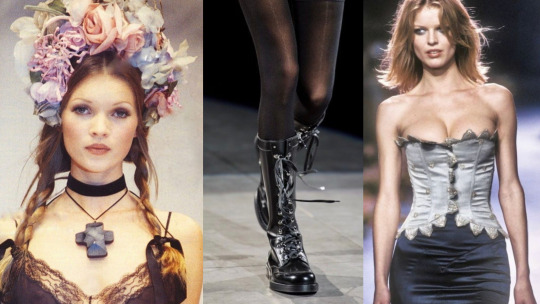

🍒 visual representation of ketu’s rather epicurean fashion taste and the darker elements in the recent gothic revival
🍒 gothic influences are also on the horizon for 2023’s fashion trends. similar to american horror story’s 2014 influences, wednesday’s and mia goth’s prevalence in social media will likely be a contributor to people wanting to branch out of most of the current trends of hyper layering, uggs, and pastels on tiktok. this fashionable extension may range from incorporating more stripes, polka dots and velvet textiles to more epicurean looks complete with cross necklaces (an ode to the ketuvian act of dying to oneself) and intricate corsets. additionally, the more edgy statements of 2014, such as dip dyed hair and shiny combat boots are likely to come in full effect. the once prominence of dip dyed hair is due to the lack of disturbance to the hair follicle and temporary coloring of the hair cuticle. being able to dye your hair, with minimal damage (such as the absence bleaching), is a great way to immerse oneself in the varying energies of each graha safely. the most common colors for dip dyed hair were blue and pink. dip dyed pink hair is invoking shukra energies, whereas azure (in addition to indigo) coloring is invoking the energy of shani. considering the lessening relevance of shukra on this year’s numerology, shani’s prevalence will likely take precedent. this is due to shani being the precursor to the teachings of ketu. where shani grants hardships, struggles, and frustration, ketu grants detachment, philosophy and maturity.

🍒 examples of the western, americana and vintage aesthetics
🍒 with the rising prevalence of mia goth, we are liking going to see a rise in the traditional/americana aesthetic (as executed in her “x” and “pearl” films). this aesthetic primarily consisting of soft music, rural scenery, folklore, and material culture which are seen as distinctly or especially "american". this americana style is characterized by nostalgia for an idealized past, often seen as "more wholesome" than modern american culture and style and a call to traditionalism. while this aesthetic is often commercialized, restaurant chains such as red robin and applebee's decorate their interior walls with a collection of mid-20th century artifacts and signage which is affectionately known as "american clutter”, modern, stylistic iterations are using traditional, western clothing that could be found in your nearest thrift or vintage store. such as, leather cowboy boots, denim overalls, white and red colored clothing (symbolic of the duality of purification and ignition of ketu), bandanas, and truly any norman rockwell and lana del rey-esc designs. this entire predicted wave of fashionable frontierism is symbolic of ketu’s call to one’s ancestral roots and unearthing/remembering those who came before us.

🍒 examples of revolutionized vintage iconography made to fit modern-day styling
🍒 within the americana aesthetic, simpler, more distressed textiles and prints will arise in popularity. modest kitten heels and nylon tights which rose to infamy in 1942 (due to the shortage of nylon), yet another 7 year, will be heavily worn. additionally, edgy elements of distressed, vintage, or pre-worn clothing, juxtaposed with layered jewelry, will serve as a subtle nod to the traditionalism and retro charm of the americana aesthetic while incorporating the aforementioned gothic elements. similar western notions of denim and low rise jeans will continue to prevail throughout 2023. many will opt for denim jackets as a casual piece, daisy duke shorts, and distressed boot jeans (perfect to pair with a good pair of boots). an overall emphasis of revealing clothing layered with tights and stockings will be seen.

🍒 dolce and gabbana autumn/winter 2020
🍒 crocheting and knitwear will become very integrated into mainstream fashion. light cardigans, heavy turtlenecks, and knitted leg-warmers, once seen in the coquette aesthetic, will turn in statement pieces. the unique and meditative nature of both artistic practices is what calls ketu natives to them. in claire nakti’s previous exploration of magha chandra natives, she noted their affinity for the practice of knitting. i believe this affinity is due to the writing of many devout catholics and christians and their juxtaposition of spirituality with the act of knitting. knitting serves as an act of mindfulness, as the craft is based upon intention and attention. in a similar fashion, those under the influence of ketu only focus themselves on pure intentions. in abstaining from engaging in behaviors that exacerbate their affinity for disassociation and choosing a practice that brings mindfulness and clarity, ketu natives are able to work towards attaining access to their tisra til. perhaps most interesting is the prevalence of christ-focused religions in the contemplation of the spiritual aspect of knitting. it is said that in order for one to go through their tisra til, they must call upon god by prayer or by the “hu” mantra (pronounced as “hugh”). the hu mantra, was the basis of the judeo, christian, and islamic traditions, that is, the ancient tetragrammaton. although the term “hu” predates all religions and belongs to no religion. it is said that sometimes in meditation or mindful contemplation, you'll hear “hu” almost as a hard rushing wind blowing, just as the apostles did when they were filled with the spirit. the mantra being considered as one’s personal love song to the higher power.

🍒 varying head covers intended for fashionable purposes yet likely resulting in spiritual benefits
🍒 another common judeo, christian, and islamic practice: head covering, will likely influence 2023 fashion. crocheted headwear, veils, ushankas, satin bows, tied silk scarves and more will continue to grace the runways of designers. paying homage to the presence of veiling in gothic subcultures and early 1940s hooded couture, by covering the spiritual vehicle that is our hair (particularly the roots of our hair). the ultra sleek, dramatic hooded silhouette is additionally worn to focus and contain one’s energy, providing clarity and a meditative focus on your ajna chakra (third eye). in regards to the eastern church practice of head coverings, bishop athanasius yohan spoke “when a woman wears the symbol of god’s government, a head covering, she is essentially a rebuke to all the fallen angels. her actions say to them, ‘you have rebelled against the holy god, but I submit to him and his headship. i choose not to follow your example of rebellion and pride.'” while many people choose not to veil for personal reasons, the act of covering one’s head or adorning it in cloth, produces similar results of inward focus and angelic guidance.

🍒 pastel iterations of the y2k aesthetic
🍒 lastly, as evidenced by my prior post, i theorize the y2k aesthetic will garner more prevalence due to its ketuvian undertones and influences. more so with less common iterations of the aesthetic that were not revived in 2022, such as plaid, micro skirts and shorts, denim skirts, and leg warmers. we will slowly start to move away from the “mcbling” aesthetic for a more subtle fit with preppy influences; symbolic of the philosophical nature of ketu. think of leather loafers, chunky knitted socks, polos, turtleneck sweatshirts, pearl jewelry, and slender, midsized bags. however, society’s fondness of pastel and pink colors within this aesthetic will slowly start to evolve for more interest in indigos, sultry blacks, neutral greys, baby blues, autumnal tans and silvery whites.
🍒 my previous exploration of the y2k aesthetic and its ketu influences aesthetic (in case you missed it)

🍒 bella hadid and vittoria ceretti for ports 1961’s 2022 autumn/winter campaign
i am interested to know if you guys are already wearing some of these trends and what fashion trends do you think will gain prevalence in 2023? i truly feel as if this year will be the revival of the 2014 tumblr aesthetic.
xoxo,
angel 💋
371 notes
·
View notes
Text
mars, ego death, and “b*mbofication” ❤️🔥

❤️🔥 heidi montag (popular y2k singer, mtv reality tv star, and model): dhanishta chandra and kuja amatyakaraka
💳 before we divulge further into the y2k b*mbo aesthetic, i think it is best to further divulge in the process’s meaning and origin. the aesthetic’s overall ditzy demeanor is symbolic of the benefits one receives from the absence of overthinking and prevention of needing to justify their behaviors and actions to others, especially those opinions who they do not truly value. thus, resulting in a jovial and advantageous attitude towards both themself and their life. the act of removing care, letting go, and radically surrendering to what comes and leaves in your life is an “ego death”. in engaging in abandoning care for frivolous occurrences and surrendering to the unknown, you are slowly encouraging ketu to enter your life, as he is said to have no head (thus, no ego, no face, no sensing, no thinking, or no expressions). a common misconception is that ketu denies, however ketu is not the embodiment of denial but rather indifference. this is why the house ketu resides in in your chart represents the aspects in your life in which you will remain indifferent towards, as you have already experienced the triumphs and tribulations of this house in a previous lifetime. in turning away from caring or indulgence, the item/person you once valued/desired now craves to win your attachment more. this is why individuals popular in this aesthetic seem to live unabashedly and frivolously and continue to receive bouts of wealth. in becoming a blank canvas or black hole (also linked to ketu), you are inviting the universe to bestow various paints (people or items) to adorn yourself with. this is ultimately why kuja (mars: the graha of rage, celibacy, determination, and power) needs to learn from the elderly presence of ketu (neutrality and disassociation) in order to abide in the graha’s naturally youthful energy.

❤️🔥 victoria’s secret angel’s bombshell campaign models: candace swanepoel: chitra surya and dhanishta chandra; doutzen kroes: dhanishta chandra conjunct kuja; josephine skriver: possible aries surya and kuja atmakaraka/amatyakaraka depending on time of birth; and lindsay ellingson: scorpio surya and potential chitra chandra
* note that the majority of vs angels themselves are influenced by kuja. the founder of vs (roy raymond) is an aries surya and dhanishta chandra atmakaraka as well
🪞 in addition to martian natives’ frequent adaptations of ketu’s care free attitudes, their frequently attractive looks are often what draws the adoration of the masses to them. this is because kuja is the son of bhumi (earth) and varaha (the boar). while i have detailed bhumi’s prevalence in depth in previous explorations, i will explore the relationship between the two deities here. bhumi, being the embodiment of the earth, is fertility and divinity. her iconography traces back to the beginning of the zodiac in aries (as she is often depicted with ashwini’s emblems of elephants and horses). her overall earthy nature and varaha’s ether elemental nature combines within the mrigashira, chitra, and dhanishta nakshatras. as each nakshatra lies in the zodiac transitional stage from earth to air (ex. taurus-gemini, virgo-libra, and capricorn-aquarius). this is because varaha was mythologized to have lifted the earth (bhumi) out of the cosmic ocean. the cosmic ocean is the container of amrita, immortality. in greek mythology, said immortality is said to be bestowed in the four horses of aries (the realm of bhumi). when the asura hiranyaksha (attacker, k*dnapper, and obstructor) stole bhumi and hid her in the primordial waters, vishnu appeared as varaha to rescue her. varaha slew the asura, and retrieved the earth from the ocean, lifting it on his tusks, and restored bhumi to her place in the universe. in a similar fashion, so too do the public respond to martian individuals. the majority of worshipping men wish to serve as each kuja woman’s varaha: saving her, idealizing her, lifting her up to the highest places in society. this is why uttara ashadha, the most masculine nakshatra, is symbolized by the similar tusks to that of aries and varaha. these tusks convey masculine power and leadership, in worshipping, adoring, and obsessing over these women, men are more called to feel powerful and energized, as evidenced by large, male-dominated corporations that are geared towards women (such as victoria’s secret).

❤️🔥 khloe and kim kardashian (both are considered american socialites, media personalities, businesswomen, and had heavily publicized s*x lives). kim: scorpio lagna conjunct kuja and chitra surya. khloe: mrigashira chandra, dhanishta lagna, and kuja amatyakaraka
🍹 whereas, it is often women who serve as asura hiranyaksha in the earthly plane, behaving as jealous or aggressive towards martian women (whether they are also kuja natives or not). this accumulation of ill will, whether subconscious or conscious, is often more harmful for the projector and not the attempted receptor. when a person chooses to become a blank canvas and chooses the impressions that may last upon them, they are able to choose to not receive or regurgitate the energy they do not align with. this usage of reflection is why kuja must learn from its proneness to accidents/tragedy and begin to reject said accidents/tragedy via reflection and indifference and not be consumed by them. this jealousy and projection is an extreme prohibitory measure in the female path. this act of feminine division is unknowingly engaging one’s rahu: the graha of difference and duality, as the aggressor/projector is dividing themselves from the martian woman (instead of being inspired and finding amrita within).

❤️🔥 emma roberts (actress known for her portrayal of a multitude of “exaggerated” mean girl characters in “scream queens”, “american horror story”, “wild child”, “we’re the millers”, etc.): dhanishta surya conjunct kuja and scorpio lagna
🛍️ in chinese practices, it is often said that when men frequently interact together in friendships, they tend to reduce their yang, individualistic nature around one another. when men are in the presence of women, they increase their yang, as varaha did with bhumi. whereas, when women frequently interact together, they increase yin in one another and garner greater beauty. this is due to the feminine, yin, watery nature of each other. the beauty and personality of a woman is said to be denoted by their chandra and kuja placements. this is why these grahas are used to analyze one’s behavior, nature, and qualities. thus, water signs are considered to be of 100% water, however the martian nakshatra’s are considered to be of a 1/4 water (with dhanishta being an exception and being 100% water, as it is designed to be the total, healed representation of martian energies). therefore, in positively engaging with martian individuals, who have some or all properties of water, one is heightening their prevalence of yin within the body.

❤️🔥 rachel mcadams (best known for her acting in romantic films and her iconic character in “mean girls”) and lindsay lohan (co-star in “mean girls”, popular y2k actress, and well-known star of the “b*mbo summit”. rachel: mrigashira chandra, scorpio surya, and chitra lagna. lindsay: mrigashira lagna, aries chandra, and kuja amatyakaraka
* note that the film was directed by tina fey (a chitra chandra and kuja amatyakaraka native and co-starred amanda seyfried (a scorpio surya and kuja atmakaraka/amatyakaraka native, depending on the exact time in which she was born) and lacey chalbert (potential dhanishta chandra)
🍒 the act of refusing to allow the jealousy and self-preservation to intrude your mind and put to rest your ego is considered a form of goddess worship. goddesses, such as the lakshmi-aspect bhumi, are infinitesimally beautiful than that of human beings. contrary to the principles of hate or jealousy many harbor against martian natives, people worship them and strive to embody that beauty themselves. in turn, they are gradually merging their image/beauty to align with her. if goddesses were regarded with the same envious treatment of most women on this earthly plane, we would be drastically divided from them. the more beauty one immerses themself in, the more your own physical vessel begins to beautify/purify, as water adds to water. this is why it is often said that you are the company you keep, you are the canvas, but who do you choose to hold the paint brush?

❤️🔥 jennifer aniston (one of the highest paid actresses of all time, frequent of 90s tabloids, and known for her portrayal of “rachel” on “friends”): chitra lagna conjunct kuja atmakaraka, scorpio chandra, and dhanishta surya
🎀 shri vidya states that beauty is equal to truth; that which is beautiful is aligned with harmony, rather than chaos or disorder. the more women allow beauty into our lives, contrary to meeting it with jealousy, the more they embody harmony and beauty itself. i am not saying all women are prone to jealousy, but it is often a feeling we all have experienced once or another. i am simply stating that we should always strive to bring ourselves closer to beauty, instead of attempting to demonize and mitigate it. beauty is exhibited in a multitude of forms other than the physical life form, from photography and painting to crocheting and engineering. i call women who are prone to jealousy to embrace other’s beauty cosmically and become inspired. this may be an act as simple as following along to someone’s makeup routine or looking to incorporate painting techniques from others into their self-portrait. inspiration is an essential part of the feminine existence, it illuminates the areas in life we can beautify and improve in in order to become more aligned with symmetry and harmony. in sanskrit, when you have a vision of a goddess, it is deemed as darshan. darshan occurs when one has pleased the deity through a certain amount of devotion (via prayer, mantra, etc.) and is aided by having a strong fire element (contrary to watery elemental nature of beauty itself, it is of ketu, the ultimate spiritual fire, relating to the power of vision and removing impurities in your perception, in order to see the truth). in engaging in jealousy, you are rejecting the goddess through the women around you, thus eliminating your chances of experiencing the great pleasure of darshan. you are rejecting inspiration, blessings, and overall beautification.
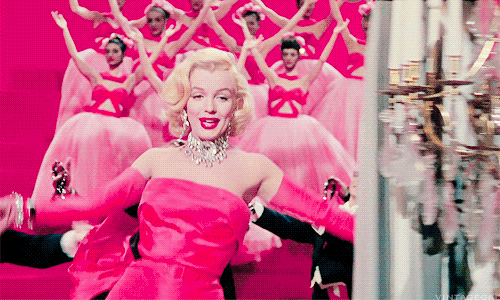
❤️🔥 marilyn monroe (the most popular s*x symbol of the 50s/60s, an emblem of the era’s s*xual revolution, and known for her comedic portrayal of “blonde bombshell” characters): dhanishta chandra and kuja amatyakaraka
🪐 according to dreamgirlarchive on here, popular symbols within this aesthetic include “designer sunglasses, playboy bunny necklaces, big watches, and silver everything”. interestingly enough, silver is said to remedy rahu, as if one is said to be facing the wrath of rahu, they are advised to drink water in a silver glass. in vedic literature, it is additionally advised to consume basil water within said glass. the water acts as a purifier, immersing oneself in kapha energies, primarily that of shukra and chandra, as they are correlated to this healing measure. the additional usage of basil is symbolic of kuja. botanist and physician nicholas culpeper (mrigashira chandra and kuja atmakaraka) noted that basil is an herb of mars and under the influence of the scorpion, referring to it as basilicon. europeans would place basil in the hand of their deceased loved ones to ensure safe passage to the next plain of existence. in consuming/adorning oneself in basil/kuja, they are granted immunity and immortality in the after life, similar to the aforementioned conquest of bhumi and amrita. additionally, the covering of eyes in the darkened, coal-esque color of ketu (sunglasses) mirrors the power of vision and its emphasis in ketu’s mythology and physical aesthetics (as many ketu natives have emphasized eyes). the emphasis of designer fashion (many fashion designers are uttara bhadrapada natives) and watches call to mind the teachings of rahu’s contemporary: shani. who counters the disassociation of ketu and correlates to denial for the promise of a greater future. as it is shani himself who is also considered to be healed by silver. this is why a popular designer in the y2k aesthetic, vivian westwood, is an uttara bhadrapada surya, and designed the popular saturn-shaped necklace titled: the mini “bas”.

❤️🔥 paris hilton (american media personality, socialite, businesswoman, and model): dhanishta surya conjunct kuja and scorpio lagna
🌱 additionally, throughout the images enclosed in this post, you might have noticed the prevalence of kuja amatyakaraka natives. mars amatyakaraka is deemed as making an individual fit for working in the army or line of defense. this placement additionally gives success in speed-oriented tasks. this makes natives especially gifted at dealing with an influx of tenacity and harmful projections from the masses and accumulating a countering army of a following/fan base. they are additionally keen at reflecting (as i spoke about previously). perhaps the most interesting nature of this placement is its gift of time/speed (shani). while their careers and fame may be quick to rise and accumulate accolades, natives of this placement must be weary and learn to pace themselves before shani humbles them. as evidenced by the frequent rises and falls of these natives’ careers and lives. overall, there is much we can learn from the women who popularized this aesthetic, attitude, and ideology: find inspiration in adoration and admiration; learn from the feminine beings around you to discover the goddess within; and, most importantly, understand that there are teachings to learn from all grahas (not just ketu, as evidenced by the involvement of shani, rahu, chandra, and shukra in the healing of kuja, despite them being considered “enemy grahas”).

❤️🔥 jayne mansfield (popular playboy playmate, titled “america’s sex symbol”, nightclub entertainer, actress/singer, and well-known aficionado of publicity stunts): dhanishta chandra and aries surya
— please take the time to list below whether my next post should be on the beauty of ashwini lagna or the beauty of swati lagna? i know i speak about beautification and femininity frequently and i can understand why i’ve received questions and messages asking me, kindly and not so kindly, to branch outside of this topic. however, as for the moment and the entirety of my account so far, this has been a great source of happiness for me. if that bothers you, i encourage to follow the multitude of others who provide vedic astrology-based content. i do appreciate all of the wonderful chances i have had to read everyone’s charts (i’ve received approximately forty orders since i began offering my services) and i appreciate everyone’s patience and kindness as i grow and refine my style. much like my posts, my readings are never truly shortened or condensed. so i apologize for their immense lengthiness and i am always open to further elaborate on what i mentioned (whether you received a reading from me yesterday or several months ago). simply shoot me an email and i will reply. additionally, my google email account appears to not be sending some readings due to their length. if you have not received yours by the receive date, please contact me via email so i can resend your reading. never feel afraid to ask, as you are most certainly entitled to receiving a product you purchased. long ramblings aside, i am so grateful for each and every one of you. i promise more nakshatra explorations are in store, i tend to heavily critique each post i make but there are plenty of drafts i may assure you all. i truly am so baffled at how there are thousands of people who want to read this blog. your prevalence, beauty, and kindness amazes me <3

❤️🔥 christina aguilera (actress and singer known for her immense vocal range and popularization of the y2k aesthetic): dhanishta lagna, kuja atmakaraka, aries chandra, and scorpio surya
**all of these placements were found using astrotheme/.com and/or astro-charts/.com. it is important to note that some chandra (moon) placements may be off by up to 6 degrees and lagnas (risings) as well, due to the fact that many websites do not have 100% accurate birth times for the given celebrities.
xoxo, angel 💋
#mars planet#vedicastrology#astrology#nakshatras#moon#rahu ketu#y2k aesthetic#y2kcore#beauty#bimbocore#aesthetic
440 notes
·
View notes
Text
my reading services & pricing 🎀

🪷 hey loves! so i have received dozens of inquiries about if i provide chart readings services. with much thought and consideration, i have now decided to offer them! your support on this blog truly means so much to me and i’m continuously amazed at how thousands of you care enough to follow my account.

🐚 as you all know, i am extremely passionate about providing insights to not only the nakshatras, but the higher realm and how you may become more in tune with the grahas and the spiritual plane. it is with these following services, i hope i am able to provide a more personalized experience for those that wish to learn more outside of my rather random posts <3
🐚 a natal and navamsa analysis ($50): this reading is designed to provide guidance to you emotionally, spiritually, and materially. i will deeply examine the intricacies of your natal chart in conjunction with the navamsa to suggest how you may better understand yourself and your spiritual path.
🐚 cosmetic cosmological analysis ($50): a detailed report consisting of planetary dominance determination and nail designs, hairstyling, outfits, and makeup most suitable for your dominant grahas. i will additionally include remedies to mediate and offset inauspicious placements in one’s chart.
🐚 vedic astrology bundle ($100): this bundle consists of both the natal and navamsa chart reading, cosmetic cosmological analysis, and two additional tarot and oracle card readings on two questions of your choice.

🌷 you will receive your readings within (likely before) approximately 15 days of your purchase. i completely understand that this may seem a long time for you to receive your readings, but i prioritize individual gnosis rather than repetitive analyses that you may stumble upon on the internet. with this, this takes a significant amount of time. i am a full time ballet and university student and in order for me to provide reading services, i require myself to be in a certain headspace. reading charts is an intimate and intricate experience and i stress that if you ever purchase a reading from anyone, you must use your own intuition and discernment to analyze if you trust the reader before purchasing—this includes me. i want to be clear, that i do not automatically expect anyone to want to receive a reading from me. however, it would truly be an amazing and humbling experience if even one of you would allow me to.

🕊 i have spent the past month reading charts for free as practice and i truly feel that i am ready to do so for others outside of my immediate realm of acquaintances or dear friends/family. please note, that despite me now offering services, i will continue to post on here. the whole entire point of this blog was to aid people in finding information on vedic astrology and other spiritual practices that is not readily accessible. so stay tuned for my new post on the differences of nakshatra manifestations in both luminaries. additionally, i’m not too sure how many people wish to purchase these services so i may have to close available readings if it begins to be too much. however, i am truly so, so excited and honored that so many of you have inquired about the possibility of me providing such. if the first month of providing these services goes well, i will likely look into creating a website to provide a more cohesive layout for you all. please message me if you wish to inquire about receiving a reading and i will get back to you as soon as i can. i ask that you all try to have patience with me :)

i truly do adore and love you all. xoxo, angel 💋
145 notes
·
View notes
Note
Hi my love, I needed to ask of the importance of D9 Nakshatras. How much do they matter?
And some insights on Vishaka?
the significance of your d9 placements 🐚 🌊

🌊 it is thought that you begin to embody your navamsa (d9) placements after you have experienced the dawn of maturity: your first saturn return. while some beliefs assume this period of change takes place during one’s time of marriage (around 27-31 years), this marriage approximation happens to coincide with dawn of shani (saturn) in one’s life. this is due to shani’s exaltation in libra: the karaka of marriage and contractual commitments.

🐚 while the navamsa can bring insights to your prospective marriage and partnership, i like to explore the other, more tangible, meanings of this chart as well. because this chart serves as the ninth division of your natal chart, it holds a magnifying glass to your true self. it determines the overall strength of your grahas by evaluating the progression of your planetary placements in both the natal and navamsa. for example:
🐚 the planetary rulers of the 1st, 4th and 7th houses of the navamsa are of divine significance. they represent the qualities of generosity, power, and wealth.
🐚 the planetary rulers of the 2nd, 5th and 8th houses of the navamsa denote one’s spiritual reputation/inclination and kindness.
🐚 the planetary rulers of the 3rd, 6th and 9th houses of the navamsa are considered to be “demonic” in significance. they are deemed as such because they represent the characteristics of “rakshasas” who are cruel, violent, and selfish in nature.

🫧 the emphasis in reading your d9 should particularly lie in house placements, rulership, and raj yogas. this is not to say that one’s d9 rashis (signs) or nakshatras are completely insignificant but they are more so considered minute in grand scheme of analysis. the navamsa is the microscopic view of one’s ninth house and is the hidden undercurrent of our fate. whereas, the natal chart is your physical existence, the circumstances you reside in, and what you are called to do. the navamsa is the hidden force, the invisible hand of destiny that decides the results of your deeds. it serves as the hand that directs and brings your natal nakshatras to fruition.

🪷 a particular misconception that i see within this community of vedic astrology is that navamsa nakshatras are to be factored in when determining physical planetary dominance. this is absolutely false. the navamsa placement itself indicates the strength of the planet which influences the possibility of physical planetary dominance. many astrologers have read the lives and souls of plentiful individuals, and done so rather accurately, without the need of divisional charts. i stress that divisional charts are a luxury and not a necessity. they are wonderful layers to add to the complexity of astrology but do not hold a candle to the primary influences of the natal chart. this is ultimately why i implore others to think of navamsa charts as the tropical astrology equivalent of asteroids. they hold influence sure, but are not what deserves the primary source of your attention, especially if you are new to vedic astrology.

🔱 also, i have made two previous posts on the vishakha nakshatra. the first post was a heavily detailed exploration of overall vishakha nakshatra beauty and the second post pertains to the social stratosphere and manifestations of vishakha chandra natives. as always, feel free to inquire about more topics in vedic astrology. i love to answer them with time and thought loves
xoxo, angel 💋
255 notes
·
View notes
Note
Hi! Could you do a brief explanation on vishakha chandra beauty?
a mini analysis of vishakha chandra natives 🔱
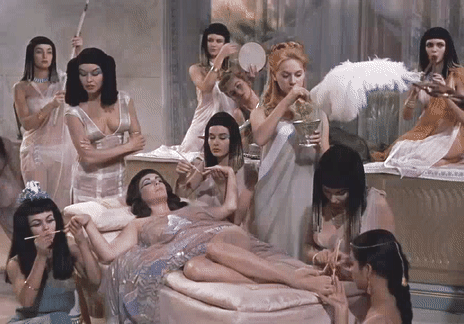
⚡️ elizabeth taylor: libra vishakha chandra
i think a deeply misconstrued aspect about the power jupiterian natives possess is their deep undertones of regality apropos to their surrounding environment. with brihaspati (jupiter) being a traditionally masculine graha and these native’s naturally domineering personalities, they are often typed as blunt and/or offensive. however, i think this preconceived notion is part of a larger picture within the realm of jupiterian natives: their gift of evocation. as i have touched on in my previous exploration of vishakha natives, brihaspati blesses those influenced under his dominance the power of bringing forth strong imagery, memories, and feelings within the social stratosphere.

⚡️ irina shayk: libra vishakha chandra
a primary theme within these natives’ lives is “to serve or be served”. leadership is integral to vishakha chandra natives. this is due to the mythology of brihaspati. ‘brihad’ (बृह्द्) means “big or great” and ‘pati’ means protector. therefore, brihaspati is the english equivalent of “the great protector” or paternal figure. brihaspati is the leader of all grahas and is regarded as the guru of wisdom and expression. he is representative of vastness, growth, and personal expansion (all of which can be harnessed by evocation). this is ultimately why the guru vishwananda correlates jupiter to the high priest melchizedek in the old testament. as melchizedek, “the king of righteousness”, ruled over the city of shalom (cosmic, harmonious peace). he is depicted in the book of genesis offering bread and wine to abram (an allusion to the sacrament of communion). he argued one’s salvation extends beyond that of individual souls to physical bodies, corporate systems, and cosmic powers. much like brihaspati and melchizedek, vishakha natives look to both obtain and give sustenance of the body. whether this sustenance is of wealth, food, sexuality, or aspirations, is up to the individual themself. but brihaspati looks to not diminish the significance of the needs of the physical body but also allude to the greater importance of the soul in the grand scheme of life. this is ultimately why you see a lot of vishakha chandra natives being tied to occultic happenings or the illuminati, such as beyonce or katy perry. while they are frequently seen adorned in flattery and idolization, they are not immune to their subversive conspiracy theories. both have been accused of secretly ushering a revolution, a new world order, brainwashing the public through music videos and dance routines.


⚡️denise richards: libra vishakha chandra
⚡️january jones: scorpio vishakha chandra
the fall. in every battle or journey towards victory, therein lies periods of disappointment or dissatisfaction with self. the janma natives of this nakshatra encapsulated this phenomenon, as this nakshatra is symbolized by the triumphant arch. duality is important to these natives but not in the mercurial reasoning that i have explored previously, these natives embody the duality of the coalescence of their ruling deities: indra and agni. they are not of the submissive, coy intellectualism of the intelligent buddha, but of the electrifying focus and will power of indragni. it is when they ignore this power of evocation of self, they fall into the turbulent spell of people pleasing. when these natives choose to over-exemplify their passion of self and aspirations, they become too entrenched in the prospect of the future and lose sight of the importance of their soul. they become too convoluted with ambition and force. hence, they duality of the fall. this is why vishakha chandras must remain balanced. they must serve—and—be served. they must explore their soul—and—the physical realm.
*it is important to note that this exploration of vishakha jamna (chandra) natives is applicable to vishakha surya and/or lagna natives as well. however, vishakha janma natives will encapsulate the manifestations of vishakha the most, as the moon is the direct manifestation of our most intimate, deepest self <3
xoxo, angel 💋
236 notes
·
View notes
Note
Yay you are back! hope you have been taking care of yourself. look forward to your upcoming posts :)
you know your hair thread, how does one find out their dosha. I really want to take care of my hair and if astrology helps...well why not 🤷🏽♀️😅
the significance and calculation of your dosha (quiz included) 🌙
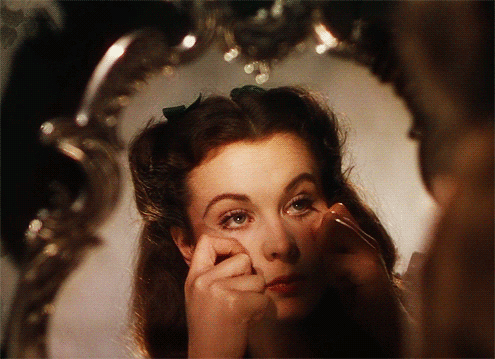
🎀 there are quite a few ways to determine your dosha. however, in my personal opinion, it is best to evaluate your physiological and metabolic properties to determine which dosha dominates you. in determining your dominant dosha, you can in turn discover which planets are likely more in tune with.

🎀 i have designed the following quiz to determine which type you are most dominant in. select the answer under each category that most applies to you. if more than one answer is applicable, choose the one that fits best:

🎀 i hope this helps you love! xoxo, angel <3
123 notes
·
View notes
Text
the esoteric meaning of “dark femininity” 🌹

💋 rose mcgowan: mula chandra
🍷 chances are, if you peruse the material, seemingly spiritual, side of tiktok, you are familiar with the concept of dark femininity. a person who embodies this concept of spirituality harnesses this phenomena to their will and is often coated in imagery of seductive reds and coal black, wields their divine rage and “shadow self”, and embodies the femme fatale aura so idolized in celebrities with a certain monstrous divinity (e.g. megan fox in “jennifer’s body”, alexa demie in her multitude of photoshoots and as her character in “euphoria” or lana del rey’s gilded glamor in her previous music videos). but what truly characterizes this seemingly physical trope that incorporates the magnetism of the metaphysical? must you have a sirened appearance, vampy looks, or a certain penchant for darkness? or do these individual features serve as an indication of the planetary and spiritual significance of the popular aesthetic/trope itself?

💋 megan fox: ashlesha chandra
🍒 i propose that it is no coincidence that the women often associated with dark femininity are primarily ruled by buddha (mercury) and ketu (the south node). for example, the insignias of the “monstrous feminine” in films, megan fox in “jennifer's body”, sissy spacek in “carrie”, rose mcgowan in “jawbreaker”, and anjelica huston in “addams family” are all influenced by the aforementioned, shadowy grahas. this reasoning lies in the hermetic views of the spiritual plane. in these films, mirroring the contemporary happenings within this world, the environment and majority of characters are entrapped in a mental prison of concealing one’s truth. whether this truth lies in murder or familial secrets, it may not be concealed for long and the characters must break from their envelopment in disillusion. what separates the main characters who are brought forth into the light of truth and those who remain imprisoned in false contentment, is the summit of knowledge. the summit of knowledge requires an understanding of all the grahas, but buddha and ketu are the primary manifestational lessons within this trope. buddha encapsulates one’s accumulation of overall physical knowledge. whereas, ketu encapsulates the journey of growing one’s knowledge of self through the past, ancestral ties, and the overall hidden secrets that buddha wishes to remain cloaked within the fantasies of the mind.

💋 sissy spacek: mula surya
☄️ this culmination of scholastics is the principle of dark femininity. the dark feminine ultimately tests one’s understanding of both buddha and ketu, as she separates the wheat from chafe. this form of femininity is often deemed dark, as it is exactly what these two grahas personify. dark femininity is not the perfect, angelic realm often associated with modern femininity, but the concept itself calls individuals back to the ancient views of spiritualism and self. perhaps the imagery of women surrounded by the blood of kuja/ketu and violent images of death in these films are alarming or disturbing to some. but these forms of self expression are truth incarnate. they may lack the pseudo appeal of modern day depictions of angels and golden gleamed gates of heaven, but that is their exact purpose. these individuals who are associated with dark femininity are intended to provoke thought and analysis. they are supposed to call forth your opinions and challenge your perceptions of society. for example, “jennifer's body” was originally poorly received with complaints and disappointed individuals who imagined the film to err on the side of pornography due to fox’s sex symbol representation in media. now, the film is recognized as a staple of 2000s imagery and an important take on the overall male-centered gazes of hollywood and a reclamation of one’s past, self, and sexuality.

💋 aaliyah: magha chandra
🌹 this “dark", however necessary, manifestation of femininity activates any remnants or loose elements of one’s perceiver's uncontrolled & animalistic nature and uses it against them effortlessly and often unconsciously, to tempt, trick, and absorb masculine energy, in order to ensure that the unbefitting remain ignorant to the underlying premise of both the film and one’s self. however, in this process of thinking, one is subject to demonizing and scorning women and the femininity/yin principle rather than penetrating and understanding her "dark" side. the blood-soaked scenes of women once idolized by the masculine individual observing in these films may invoke fear or perhaps starlement. this is intentional, as fear is infinitsesimely more powerful than sexual enjoyment (according to tantra).

💋 katharina isabelle: mula chandra
🥀 within the occult law, these feelings of abnormality or fear in cinema are used to drain and entrap the observer’s knowledge. by entrancing one’s onlooker, the individual is able to harness the onlooker’s power/aura. this reasoning is due to one’s yoni being capable of endlessly reproducing and mimicking previous impressions (as buddha has mimicked in previous mythological stories referenced in this blog). it is said that the goddess kali resides in the middle of the yoni. kali is representative of frightening qualities that coincide with freedom from the bondage of time or death. she proposes and evokes what may make those unknowing uncomfortable. this goddess rulership is pertinent to understanding the demonicism of dark femininity.

💋 alexa demie: jyeshta surya
🦂 women have long been taught their value is measured by their sexual attractiveness, their unconditional support of men, and their unselfish maternal support of their children. told to be ‘good girls’, to listen to authority, and that their sexuality is something to give to others rather than for themselves. this version of the feminine, often referred to as the “light feminine”, embodies an open heart, compassionate, a caring mother, devoted wife and committed friend. however, removed from the depth of her life-force energy, she lives a one-sided and disempowered life, unable to bring fruition to her true self in this world. when only this form of femininity is developed, one often tends to have poor boundaries. having spent so many years taking care of other’s needs they often don’t know where their families or career end and they begin.

💋 lana del rey: ashlesha chandra
🕷 the contrast of this westernized form of femininity is the “dark feminine”, who frequents the halls of power, is free from the aforementioned trope’s need to shine brightly. the dark feminine has been repeatedly shamed and wronged by our society, she is the whore archetype, relegated to the unconscious, the shadow, something to be considered as evil. she is an intense and fiery emanation of mercurial and ketuvian energy. an expression of the deepest regions of the human psyche, she illuminates our desired nature and holds the power the light feminine is withholding from itself. arising from the earth, from the mother, from matter, she holds the key to the awakening of sexual energy, of the primal life force.

💋 salma hayek: revati chandra
🕸 when one aligns themself with kali, they are guided to disillusionment and reclamation of self. they have become attune to their previous history of misunderstandings, alienation and diminishment. in this fully awakened state, one represents emancipation from limitations, freedom and autonomy. the individual is relieved from their previous patterns of betrayal and consciously empowered. this awakening is symbolic of the lunar shedding of one’s blood during their menstrual cycle. the intuitive graha that is chandra (the moon) influences the shedding of blood (the domain of kuja, the associative, manifestational graha to ketu). in previous, mythological encounters and astrological observances, the coalescence of ketu and chandra have been deemed to be turbulent. this reasoning is likely due to lord ganesha (the deity associated with ketu) once cursed chandra for the deity’s pride and vanity. the curse stated that anyone who observes the moon on the ganesh chaturthi (a date often occurring during the solar return of magha nakshatra) will be falsely accused. the curse was eventually uplifted due ganesha’s forgiveness.

💋 anjelica huston: jyeshta surya and magha chandra
🃏 this story is ultimately why women are oftened subjected to the category of either the “whore” or “virgin”. whether one is celebrating their accolades, knowledgeable of their worth, or enamored with the beautification of self, society is quick to label them as “superficial” or accuse one of achieving their goals through illegitimate means (regardless of the validity of their statements). coating oneself in the knowledge of the shadows, realms, or accumulating other’s aura serves as protection against this occurrence. hence, the mystery surrounding popular mercurial natives, such as rihanna, alexa demie, or angelina jolie, and ketuvian natives, such as rose mcgowan or anjelica huston.
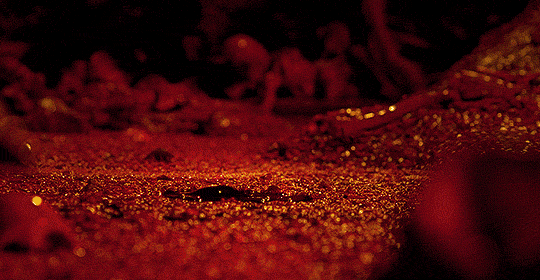
♠️ their signature appearances are an overall ode to their planetary dominances. their vampiric hair utilizes the color of black to both propel the energies of others, symbolic of the blackened skin of kali, serving as a biological hamsa (more on the spiritual importance of black hair in my previous exploration of hair types). their signature siren eyes are physiologically indicative of their hyperexpansion within and sly personality, as both ketu and buddha’s yonis are exemplified by coy and energetic animals (such as the rat, cat, and horse). whereas, the frequent association with reds in the aestheticized version of dark femininity are symbolic of the flames of kuja, one’s cycle, and the red shoe flower that is offered to kali to annihilate one’s demons. will you adorn yourself in this imagery of energetic protection?
i apologize for my absence, as most of you know, i am a full time athlete and am pursuing three undergraduate degrees currently. my goal is for my posts on here to never feel as a chore and, therefore, i usually post sporadically and in a rather discombobulated manner. my next post will either be on the beauty of chitra or a style/makeup/hair analysis of euphoria outfits from a vedic perspective <3 hope you all are enjoying this lovely summer and pursuing your scholastic endeavors (academically or spiritually)
xoxo, angel 💋
"what are we made of but hunger and rage?" - anne carson (magha chandra)
#yoni#vedicastrology#astrology#nakshatras#tikshna#ketu#moon#buddha#mercury#dark femininity#dark feminine energy
805 notes
·
View notes
Note
hiii i was just wondering if you could explain/elaborate on the connection you made between parvati and hasta in your thread on that nakshatra? thank u sm super appreciative of all your research n insights! <3
the correlation of parvati and hasta 🌙🌷
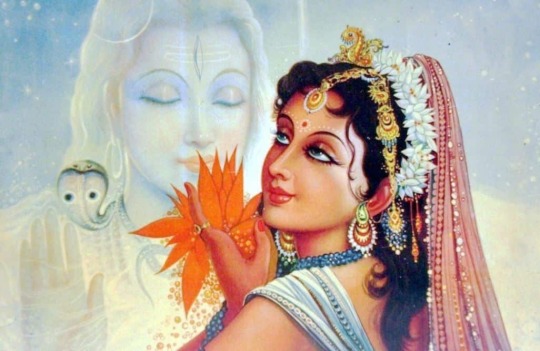
in my previous exploration of hasta, i detailed the prominence and importance of parvati in understanding the symbolism of the hasta nakshatra. the deemed sacred temple for hasta is the komal temple of kumbakonam in tamil nadu. it is recommended that hasta chandra natives visit this temple before they depart from this earthly plane to receive blessings, divine grace, and godly compassion. this worship will cloak them in the energetic vortex to guide them in the afterlife. when offering oneself to komal, natives are required to praise shiva (the husband of parvati) and adorn their hands (the prana life force of hasta) in water, to align themselves with their lunar, kapha nature to connect with their ancestral powers.
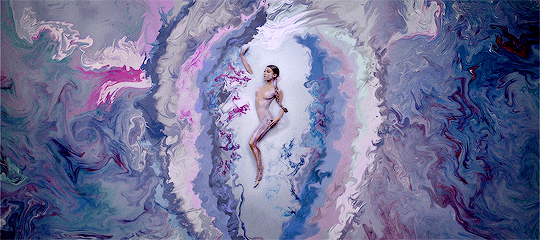
🌀 ariana grande: hasta chandra
the significance of komal lies in the goddess parvati. long ago, parvati wished to understand the exact experiences of lord shiva when he ruled the universe. because shiva participated in the divine sport, parvati decided to follow suit to absorb the knowledge of shiva. parvati playfully covered lord shiva’s eyes with her hands, but this action subsequently caused the entire universe to become incapacitated. parvati stopped the flow of earthly water, the movements of planets, and at once everything in the universe became still. overcome with guilt, parvati asked lord shiva for his forgiveness. shiva explained to parvati that due to her actions, he would disappear into the light known as "hastayama jyoti" created by his own hands. parvati would then incarnate as a cow wandering around the world in search of shiva until she reunited with him in the form of "hastayama jyoti." parvati was distressed, but followed shiva’s orders and wandered the earth as a cow, searching for lord shiva’s light. finally, on hasta star day, lord shiva revealed his light to parvati and bestowed darshan as sri kirupa koobareswarar.

🌀 monica bellucci: hasta surya
parvati’s playful nature is symbolic of the mercurial, lucrative energies of hasta natives. her goals of attaining the never ending knowledge of the divine is a metaphor for the intelligence (mercurial) and intuitive (lunar) nature of janma natives. parvati using her hand (the palm of blessing) to cover shiva’s eyes (gateway into one’s soul) is reminiscent of the feminine moon trying to eclipse the masculine sun. this futile pursuit for knowledge is ultimately why parvati is said to be a deity of the moon. as she wields her playful, seemingly “earthly” nature in hopes of gaining further spiritual fulfillment. so too do hasta natives yield their conniving, yin intellect for the yang energies of others. this is additionally why savitar (the solar deity) rules such a lunar nakshatra. parvati is the key that unlocks the multidimensional pathway of savitar. no one can bow to the sun without understanding the moon. the two are inseparable and must be treated with equal integrity. as seen in the hasta sthapaniya agama shakti: the power to gain what we are seeking and to place it in our hands.

🌀 bella hadid: hasta surya
our hands possess the fate of our souls. this is why many palm readers are hasta natives because our palms hold the keys to divulging our destiny. the significance of parvati, the womb of the universe, being turned into a cow amplifies the importance of the hand. cows are condemned to the earthly plane but hold divine, ever-giving, undemanding nourishment. for parvati to become entrapped in this selfless, pouring form is immense in an esoteric sense. cows were once solely milked by the hand, to use the vessel of destiny to harness sustenance and nourishment is an exchange of magical energy. hence, the concept of the sacred cow in numerous cultures, such as the “glas gaibhnenn” in ireland, the incarnation of the goddess aditi in india, and the mythological origins of cattle in chad. they are cosmically considered the vessels of earth.

🌀 alicia silverstone: hasta surya
uttara phalguni being symbolized by the cow yoni is the cosmic transition of the fiscal, sexual rat of magha into the cow of parvati. the flourishing nature of cow is often why uttara phalgunis also possess such magnetism, specifically in the p*rn industry (with many popular stars being uttara phalguni natives). the masculine public unconsciously recognizes the ever flowing nature of these natives and collectively wishes to adore and admire them. often so entranced with their sexual energy, they idolize these natives from afar and become flabbergasted at the mere vicinity of their presence. the public often views these solar natives as “stand-offish” or overly-independent only to not realize that this is simply their projection onto surya. they long to attain the powers of savitar, only to be imprisoned by the rays these natives produce. collectively waiting for their intellectual destiny to be fulfilled (as parvati once did).

🌀 laetitia costa: hasta lagna
parvati and shiva are often depicted even more intimately linked as ardhanarisvara—the "lord who is half woman." statues and pictures of this deity are differentiated into male and female halves along the central vertical axis, the male half bearing traits of shiva and the female half those of parvati. this particular type of depiction solidifies the fact that male (savitar) and female (parvati) are inseparable in the process of creating life, and in the case of shiva and parvati, the culmination of the universe itself. parvati is also depicted alongside her husband in more abstract form as the yoni, a vulvular shape, which compliments the phallic linga which represents shiva.

🌀 dita von teese: hasta surya
this ideal configuration for harmonious life is a beautiful depiction of the devotional element of the female path. as parvati avoids the materialistic connotation of knowledge and embraces true devotion and passivity to her yang source (shiva). parvati embraces the true feminine energy of hasta not by ejecting energy as uttara phalguni, but by responding to male energy. these natives learn to conserve their personal energies by absorbing and radiating the sunlight of others. they appear in the forms those who perceive them deserve, hence the mercurial “joker” archetype.

🌀 brigitte bardot: hasta surya
parvati is the immersion of the yoni incarnate, her vulvular being is the gateway to all of the cosmos. parvati is said to reside in the bharani nakshatra (the yoni) because of said aforementioned symbolisms and parvati being the mother of lord ganesha (the elephant yoni from which bharani is said to embrace and the gateway deity to hasta). the two cosmic phenomena are linked to the ichthus. the ichthus is a symbol of two intersecting arcs that resemble the yoni. both are considered to be the gateways to the universe via life and death. both have the discernment to separate “the righteous from the wicked at the end of this world” as evidenced by matthew 13 in the bible. the elephant’s face is symbolic of the triangular formation of feminine genitalia. this downward triangle is the alchemical symbol of the water element: the kapha waters of the moon, the lusciousness of parvati, and the feelings/intuition of prosperous shukra (please read my previous post on vishakha for more information on shukra). therefore, parvati is the ultimate feminine being for understanding the base paths of feminine divinity.
overall, i hope this explains why parvati is so important to hasta and divine femininity in general 🤍🌷
xoxo, angel 💋
#vedicastrology#astrology#nakshatras#moon#parvati#hasta nakshatra#virgo aesthetic#virgo astrology#uttara phalguni#bharani#shukra dev
281 notes
·
View notes
Note
hii i love your blog <33 if you haven't yet, can you do beauty of vishakha lagna? if you already did do you mind giving me the link to the post? I can't find it :(
thank youu so much :)
absolutely hun! i truly adore all of you vishakha lagna natives <3
the beauty of vishakha ⚡️: an analysis of destiny, love, femininity, and the creative path (part I)

⚡️taylor swift: scorpio vishakha lagna
i encourage anyone wishing to understand the influences of shukra, brihaspati, and vishakha to read this post, as i intertwine their respective principles throughout! additionally, as you read this post, please listen to this vishakha playlist i made for the full experience:
*MAJOR TW// i discuss a lot of potentially triggering topics, i.e. abuse and the s*x industry.
⚖️ in the beginning of the libra rashi, we learned how to accumulate merit throughout life from the punya cayani shakti (the shakti of the chitra nakshatra). bestowing the innate ability to find the equilibrium between difficulties and enemies (the virgo rashi/sixth house) and law (a characteristic of the seventh house). in doing so, chitra combines the qualities of both law and truth to produce fruitfulness. chitra is the lesson that shows us the power in righteousness, accumulating the astute intellect, and applying the dharmic principles throughout all aspects of life, while simultaneously savoring and enjoying the sweet progeny that is the fruit of our labor. it’s the joy of the most tired miner who eventually uncovers the rarest jewel of them all. in the heart of libra’s rashi is swati, who accumulates the most venusian energies out of the rashi, extracting the energies of shukra and wielding it’s airy element under the supervision of vayu (the god of wind). these natives have the unique pradhvamsa shakti, the ability to scatter like the wind. it can mold and move ether and transform the prana of the body. while having this shakti is incredibly powerful, these natives run the risk of destructing what the wished to only reconfigure. this disharmony is often a result of abiding in the shadow states of rahu and shukra. the ethereal winds may heal or harm but will always result in an end product of transformative breakthroughs or major energetic shifts. swati has this almost indescribable freedom of motion and movement and distortion. they are not held to the same responsibilities of others because they control what the concept of responsibility is in itself. their only fault is struggling with building consistent endurance and perseverance. however, this is the only way they can master their beautiful gifts and grant eternal existence to not only the things they morph/reconfigure, but grant eternal existence to their higher state. in the final portion of the libra rashi, vishakha’s fiery path leads us to the destination of scorpio, but this energy differs from chitra or swati. it is the dawn of divine combination, the swirl of potent energies. vishakha is the shelter of shukra, kuja, ketu, brihaspati, indra, and agni. what lies on this path is both energetic cultivation and the lightning that which calls upon the cosmic powers bestowed by the divine.
🌸 the entire libra rashi is linked to kamala, the tenth mahavidya goddess. the goddess kamala is traditionally said to be linked to shukra and she is considered to be the supreme form of the tantric goddess. kamala is also considered to be a form of goddess lakshmi (the goddess of material fulfilment and contentment, luxury, and fertility who is also said to be a manifestation of shukra). hence, kamala is regarded as the tantric lakshmi. in her mahavidya state, kamala also bestows matters of lakshmi and shukra when she operates in her higher state, such as prosperity, fertility, and good fortune. kamala is often portrayed as making the gestures of boon-giving and fearlessness. she sits on a lotus and holds lotus blossoms in her two upper hands, correlating to her name meaning “lotus” (symbolic of the lotus of surya). while kamala is not a divine consort to a male deity, she is representative of the independent and all-supreme divine mother. kamala does represent divine auspiciousness that is birthed from the mother but she is not completely auspicious or solely devoted to matters of prosperity. it is sometimes said she is referred to as rudra, “the howling one”; ghora or bima, “the terrifying one”; and tamasi, “the dark one”. kamala encompasses the ugra, crocodile features of shukra and the rejuvenating purity of shukra. a common misconception about venusian natives is that they all inherently favor matters of lakshmi and want the finer, more luxurious aspects of life and only seek to embody the utmost refinery of the soul. what people fail to realize is that these concepts cannot be fulfilled or implemented until you understand and worship alakshmi (the goddess of misfortune and grief) and cross the figurative muddy waters to sit on the highest plain of utgrasati.
🔪 to clairfy, ugra is not solely associated with the vimshottari venusian nakshatras (bharani, purva phalguni, and purva ashadha) but also purva bhadrapada and magha. ugra is often translated as “fierce”, occasionally “angry”, but actually it is said to truly mean “utgrasati”, the etymology of ugra. the term utgrasati means “one who sits at the highest plane”. this highest plane/realm being ugra. this is why it is common to see ugra dominant individuals, specifically women, who avidly play anti-hero hero characters or save others and use tactics of bodily discipline and weaponry in films. such as, lucy liu (possible bharani chandra) in “charlie’s angels”, uma thurman (bharani surya and magha lagna) in “kill bill”, and krysten ritter (purva bhadrapada lagna and magha chandra) in “jessica jones”. ugra has the ability to sit above on it’s higher plane but also is capable of bending down and elevating others to join them in this higher state. this is a quintessential characteristic of all ugra-influenced individuals. most people struggle with building the capability and personal foundation to save the lives of others, sometimes even ourselves. however, the ugra devatas, naturally wish to exalt their surroundings. the final venusian vimshottari nakshatra is the purva ashadha nakshatra. the shakti of this nakshatra is the varchograhana shakti. similar to the bharani, this shakti is correlated to the divine element of utmost femininity: water. as the varchograhana shakti uses the nature of water to bestow a heavenly like quality within and the ability to provide inner purification.
⛓ there is a specific cycle of death and rebirth that is referred to as samsara. in ancient texts samsarana, is said to mean "going around through a succession of states, birth, rebirth of living beings and the world", without obstruction. it is a metempsychosis of sorts that represents the transmigration of the soul. samsara is frequently contrasted with the concept of moksha: representing spiritual liberation and enlightenment. the cycle of samsara is often repeated and executed involuntary throughout the lives of most people, it’s materialistic nature satisfies those who value luxurious expression of lavish means. this phenomenon establishes a false illusion of ownership over the world and their surroundings and can leave one forgetting about the necessity that is moksha. people mistake samsara for freedom but, in reality, it is binding you from moving into the spiritual realm of ugra. beyond the mystical well of the conjunction of libra and scorpio, there is an abundance of freedom and radiating heat from the nakshatras mula, purva ashadha, and uttara ashadha. these natives of vishakha must learn to crawl out of this well of comfort and contentment. it can be tempting to remain indulgent in samsara and the waters of maya and struggle with seeing beyond our current surroundings. simply reveling in the connection of all occurrences to ourselves and refusing to break the shackles of identity.
🌑 kali yuga is the fourth and present age of the world cycle of yugas or "ages." it is also the end of the four ages that comprise a cycle and is often referred to as the dark age of spiritual degeneration. when one is submerged in the throws of kali yuga, it is said that god will come in the same nakshatra and save you. this is because each yuga has a corresponding nakshatra associated with it. the yuga avtaara will come bearing that nakshatra as their janma/chandra nakshtra and will spread light to the world.
⭕️ each yuga is said to be connected to a certain rashi: satya yuga is connected to aries; treta yuga is connected to cancer; swapara yuga is connected to libra; and kali yuga is connected to the final movable rashi of capricorn. makara (otherwise known as capricorn) is defined by being encompassed in mysterious illusions and symbolisms which cannot be easily fathomed nor defined by the exoteric cycles of nature. these mysterious revelations refer to the core meaning of the capricorn rashi: the tropic of makara. the tropic of makara is theorized to be the seat of the guardians of this globe, correlating to the direction of capricorn facing north. the north direction is ruled by kubera (the god of wealth and guardian of the world). therefore, capricorn is relative to the spiritual impulse which guides the world towards its destiny. it is the process in which one universalizes the collective energy of this physical plane. during the universalizing of the people of this earth, there will be hardship and suffering. thus, activating our spiritual mechanism of involuntarily aligning our consciousness with thought currents and vibrations from the higher realms of existence and the governing powers of the universe. due to this distancing of oneself from samsara, on the material or maya realm of living, difficulties and dissatisfaction with contemporary expressions of wealth may arise, but inwardly the manifestation of makara will bring peace with one’s spiritual purpose.
💸 kubera’s mythology and etymology is the perfect analogy for the purpose of capricorn. as mentioned previously, kubera is considered to be the god of wealth and the god-king of the semi-divine yakshas (typically benevolent spirits who dwell in nature). kubera is often depicted as a dwarf, with a complexion adorned with lotus leaves, and a big belly. he is described as having three legs, only eight teeth, one eye, and being adorned with jewels. these descriptions of deformities, such as the broken teeth, three legs, three heads and four arms appear only in the later puranic texts. he holds a mace, a pomegranate, or a money bag in his hand and is occasionally seen carrying sheaf of jewels or a mongoose with him. kubera’s seemingly “unusual”looks symbolizes the external distancing of oneself through the rashi of capricorn, in order to further oneself spiritually. the pomegranate is a symbol of prosperity and fertility, similar to kubera’s yakshas and moksha-bestowing lord ganesha (who is said to be fond of fruits with seeds). as the pomegranate is fruitful and bountiful and cleansing, as the jnhm (pomegranate), was once used to treat infections by the ancient egyptians. whereas, in tibet, the mongoose is considered a symbol of kubera's victory over the nagas—the guardians of treasures. in addition to the mongoose being the solitary, victorious yoni which resides in primarily the capricorn rashi.
💰in the vishnudharmottara purana, kubera is described as the embodiment of both artha ("wealth, prosperity, glory") and arthashatras, the science of wealth. his iconography mirrors his association with artha, as his complexion is described as that of auspicious lotus leaves. he is adorned in golden clothes and ornaments, symbolizing his wealth. his left eye, the eye of chandra, is yellow, symbolizing his internal harmony and imagination. the vishnudharmottara purana further describes his face to be inclined to the left, sporting a beard and mustache, and with two small tusks protruding from the ends of his mouth, representing his powers to punish and to bestow favors. his wife riddhi, representing the journey of life, is seated on his left lap, with her left hand on the back of him and the right holding a ratna-patra (jewel-pot). whereas, kubera holds a gada (symbol of dandaniti: the administration of justice, standards, shakti, and the quasi-divinity of royalty) in his left pair of hands. he is also depicted bearing a lion—representing artha as well. whereas, two of the treasures, padma and shankha, stand beside him in human form, with their heads emerging from a lotus and a conch respectively. the lotus/padma being symbolic of the minerals and jewels in the himalayan lake and the conch shell/shankha corresponds with higher frequency universal sounds associated with hindu belief of musical spheres.
🐚 the sound of the conch shell or shankha symbolizes the sacred om sound (the essence of ultimate reality and conscience). vishnu holding the conch represents him as the god of sound. brahma vaivarta purana declares that shankha is the residence of both lakshmi and vishnu, as maa lakshmi is the consort of vishnu. due to shankha being the abode of lakshmi, bathing by the waters led through a shankha is considered as bathing with all holy waters at once and frees one from the cycle of births. it is even said the mere sight of the shankha dispels all sins as surya dispels the fog.
🌞 the third note in indian raga (a pattern of notes having characteristic intervals, rhythms, and embellishments) is the sweet sounding gandhara note. it is the first note that sounds harmonious and is extremely auspicious when audibly consumed. it is a good omen that is considered to be deva loka and determines whether a raga will be joyous major or sad minor. this essential role of determining the character of the raga, is symbolic of surya who rules our very self and personality in vedic astrology. interestingly enough, the swapta swara gandhara originated from the sound of a goat (the emblem of capricorn). now, the conch shell has been incorporated as one of the eight auspicious symbols (ashtamangala). the right-turning white conch shell (therefore, moving in the direction of yang/surya), represents the elegant, deep, melodious, interpenetrating and pervasive sound of buddhism, which awakens disciples from the deep slumber of ignorance and urges them to elevate oneself and ensure welfare of others. in this state/sound, we have learned the power of authority, judgement, and guardianship from kubera; how to cleanse and awaken ourselves in the shankha, determine our self/spirit in the solar purity of gandhara; and we are now able help others and embody utgra sati.
🌊 one of the aquatic nature of the water-, earth-, or mine-dwelling nine treasures (or nidhis) is the makara/crocodile. in the throws of kali yuga, it feels as if you are drowning in a deep, crocodile-infested trench. here in the capricorn rashi, even brihaspati is debilitated. in order to free ourselves from this trench, we must turn to the other guru: shukra. in kali yuga, another graha must uplift and aid lord brihaspati and the guru to the asuras is able to do so. because, in order to uplift others, we have to elevate ourselves so much so that we will not fall into the ditch of the shankhas we originally cleansed ourselves with. if our spirit is not stable enough, we will be incapable of helping others, as you cannot pour from an empty shell. because the ugra devatas are confidence in their internal composition and stability, natives of shukra have the ability to uplift those drowning in makara. this reflects the nature of the nakshatra of shukra and shankha: purva ashada. because of its residence in the sagittarius rashi, purva ashadha natives have the innate ability to battle, fight, and educate their surroundings to beautify the lives of others. this is why some astrologers theorize the yuga avatar is going to come in the nakshatra of purva ashadha, bearing both the knowledge of shukra and brihaspati. dharma can then be reinstatated. this is why the agni purana states that kubera should be installed in temples as seated on a goat and with a club in his hand. the goat being symbolic of the symbolism of makara and the club showing what it means to truly fight for others and the weaponry of the mind by simply aligning the opposing sides of knowledge within ourselves, embracing the guru of duality (shukra) and the guru of wisdom (brihaspati).
💎 similar to the first mahavidya kali (representative of shani), the tantric form of kamala embraces both the light and dark undercurrents of life, for she is totality. she understands the maya of samsara; the waters of shukra, shankha, and rudra and the bharani/purva ashadha shaktis required to cleanse ourselves; the power that results from the combination of ugra and tara, and the necessary duality of lakshmi and alakshmi. you can not reap the diamond, without sifting through the coal (chitra). you cannot gain or lose in life but only morph and reconfigure your surroundings as you flow through the currents (swati). in vishakha, you cannot reap the fertile crops of kamala without the ability to achieve our goals abundantly through the force of time (kali).

⚡️grace kelly: libra vishakha lagna
⚖️ in the libra rashi, particularly the vishakha nakshatra, we see themes and elements of sexual abundance and overstimulation of shukra driving one to exploring sexual spirituality or, in more disturbing circumstances, towards harmful sexuality. it is a reoccurring theme for western libra celebrities to be candid about their participation in tantric acts. think of celebrities like gwyneth paltrow (libra chitra surya), sting (libra swati surya and chandra), scarlett johansson (libra vishakha surya), sean combs (libra swati surya), and heather graham (libra swati chandra) who have been frequently quoted for their appreciation of tantra. however, it is important to note that the common western popularization of tantric practices is typically inaccurate and both neglects the vast majority of nonsexual practices of tantra and sensationalizes what seems most appealing or convenient at that time. tantra should be taken seriously and not just flirtatiously used in a terminological sense. another person’s culture, religious traditions, or spirituality should be approached with respect and not used as a trendy fashion statement.
📖 the tantric books themselves act as a guide and explorative avenue for growth and harnessing our libido and intertwining that with our spirituality. one of the many characteristics of tantra is its use of mantras. while i implore you all to delve into the tantric books to familiarize yourself with this concept, i will try to sum up this concept as easily as possible. in the chapter pertaining to mantras in tantra, terrestrial water is drawn by the power of surya and rises to the solar region. it is this power of the sun that is referred to as rudra. the three gunas, sattva, rajas, and tamas, are respectfully considered to be the creatrix, preservatrix, and destructress, as these three shaktis whose forms are meditated upon in the solar orb at the three sandhyās. in the creation, preservation, and destruction, which take place in our everyday lives: the morning sandhyā is a period of creation, the noon sandhyā is a period of preservation or maintenance, and the evening sandhyā is a period of destruction. in the morning, the world is freed from sleep, the tāmasa shakti of dissolution (the dominant shakti at the time) is loosened from the grasp of darkness and awakes. during the night, the universe, although existing as before, remains covered by a film of tāmasa, “so that, notwithstanding its actual existence, it is not perceived by jīvas in a state of sleep. for this reason, the universe must then be considered “non-existing,” otherwise dissolution' has no meaning.”. in dissolution, the world of jivas exists in the womb of prakriti in a subtle form as seeds and then later the first blooms of creation appearing through the power of brahmashakti. during this daily of form of creation, brahmashakti’s shakti, meaning “to make things able”, bestows the power by which things can happen or transpire. that power belongs to brahman/god and can manifest in a variety of ways. at sanndhya, the sadhaka worships the three powers of the brahman as the creator (brahma/brahmani), the maintainer (vishnu/vaishnavi), and the destroyer of all things (shiva/maheshvari).
✨ in the evening, when the world of jivas participated in its daily activities and the weary of body seek to enjoy the blessing and balm of the sleep of dissolution, it is then that shivashakti, she who gives the unalloyed bliss of the enjoyment of the balm of dreamless sleep and is the destructress of the universe, appears (in order to provide that balm) in the solar orb in the form of maheshvari. she covers life with the veil of tamasa shakti and drops the curtain of sleep on the samsara, the maya playground of error, and dispels from the minds of jivas all the impressions which they have received from the outer world. tantra describes mahāprakriti as the aggregate of the three shaktis of creation, preservation, and destruction who is composed of the three gunas of sattva, rajas, and tamas. “it is not that when one of the guna is in play that the other gunas remain dormant. the eternal play of creation, preservation, and destruction is ever equally present in her, but we fail to recognize this with our imperfect vision. let us suppose, for instance, that we see a hungry tiger killing a deer. we think that it is the play of destruction of the mother of the world. but a keener insight into the incident will make it clear to us that even in this play of destruction there equally exists, in succession, the play of the three gunas of her whose substance is the three gunas. we see only the destruction of the deer. but although this is a case of destruction so far as the deer is concerned, it is a case of preservation if we look at it from the point of view of the tiger. for the tiger's body is preserved by the blood and flesh of that deer. again, the generation of the tiger's cub is due to the maintenance of the tiger's body. consequently, what is destruction for the deer is creation for the tiger's cub, just as our own eating involves destruction of the seed-power of the tree, preservation of ourselves, and creation of our children.”.
🌬 this is why it must be understood that in mahaprakriti, the three manifesting forms of the three gunas exist equally and always, but they appear as creation to some, preservation to others, and destruction to the rest. for example, the same water which quenches the thirst and gives life to one man may give death by drowning to another. what do you associate water with? the power of preserving life or the power of destroying it? the makara is born in that same water and lives in it and will not survive for a long period of time without it. are we to understand from this that water has the power of creating and preserving life? the same sunshine that destroys the life of the wayfarer oppressed by summer heat in some far-stretching plain gives life to the cold traveller whose limbs have been stiffened by the fall of snow. does this indicate the life-destroying power or the life-preserving power of sunshine? without sunshine, trees, shrubs, and flowers would dwindle and die. however, this very sunshine draws water from the earth and carries it to the solar orb.
☀️ the energy which draws water from the earth is rudra, meaning “terrible”. the same solar energy which previously manifested as a nourishing different form of energy then assumes a tamasic role, due to its purpose for drawing water. this is why, although it is solar energy, it is simultaneously rudra. thus, sunshine is called “rudra”. the term “sun” is used to describe a mass of compact energy, while rudra or sunshine is the name of the rays which it scatters off of its surface. tantra states, “the difference between the sunshine and the sun is the same as that between the waves of the sea and the sea. just as in the sea, water exists in a collected form, so in the solar orb energy exists in such form. just as in the sea single waves heave eternally, so do waves of energy in the solar orb. it must, therefore, be understood that wave is the same thing as water, and sunshine is the same thing as sun.”. the solar orb lies above (terrestrial water) and terrestrial water lies below (the sun).
⚡️ the issue with vishakha natives is they struggle with their perception of the three forces (creatrix, preservatrix, and destructress) and the gunas. they act as the tiger of mahaprakriti, the yoni of vishakha, and wish to stalk their prey to feed and preserve their ambitions, only to find themselves blinded by their pursuit and embodying the forceful state of rudra and drying their well of makara before they can peacefully drink from it. thus, eradicating their own personal preservation of spirit. they become blinded by power, this, in culmination with their innate spiritual abilities, can result in a multitude of dangerous behaviors (that i will elaborate later on).

⚡️vanessa paradis: libra vishakha lagna
🪷 during my hiatus from this platform, i heavily divulged into venusian manners and projections. as i was perusing the pages of “the life of the mind” by hannah arendt (purva phalguni chandra), i was further awakened to the cosmological significance of the teaching of shukra vs brihaspati.
🪬 i quote arendt’s words on understanding the thinking process of the mind from a metaphysical (the transcendence of reality) vs philosophical (the fundamental essence of reality) standpoint: “was it not precisely the discovery of a discrepancy between words, the medium in which we think, and the world of appearances, the medium in which we live, that led to philosophy and metaphysics in the first place? except that in the beginning, it was thinking, that was held to reach truth or true being, while by the end the emphasis has shifted to what is given to perception and to the implements by which we can extend and sharpen our bottle he senses. it seems only natural that the former will discriminate against appearances and the ladder against that thought”. it was often considered that both metaphysics and philosophy stem from the origin of poetry, an undoubtedly knowledgeable plane. therein lies a distinct need for intellect and knowledge in order to further cosmological understanding. similar to the kabbalah, brihaspati and shukra are intertwined via the chesed (jupiter) and (netsach) branches, which are immediately connected to each other. chesed is the love in which one feels for god and is the basis of mercy. it’s the charitable sustenance that nourishes those around someone. this is why it is able to channel netsach, as shukra is the mercy incarnate, hence it’s connotation with the “fall” or lucifer himself. whereas, jupiter gives thanks for the mercy and receives. venus is constantly discharging (hence, the popular “shukra/s*men” association) and projecting its desires onto the metaphysical. brihaspati is the nourishment within, his process is not as direct or refined, but slower and atomic. similar to how fat takes awhile to accumulate in the body, so too do brihaspati’s works take awhile to accumulate into philosophical fruition.
🫧 a primary example of this distinction is david lynch (libra vishakha lagna) in an interview with charlie rose in 1997. he describes his distinction between daytime (the summit of terrestrial waters) and night time (the peak of jīvas) dreams and the energetic properties of both. he states he prefers day dreams, as it is a meditative practice in which “the dream takes over” (aka the waters of the outer plane). furthermore, he describes this practice as an “unraveling” without intervention. the presentation of creative works is revealed to him, as the turbulent spirits of rudra (the storm) are eclipsed within the mind. this is ultimately why many vishakha natives (specifically lagna placements, as it is the sun being eclipsed by the energies of indragni) benefit from utilizing their minds during the day to create and refine their artistic endeavors. for example, many venusian/jupitarian ceos have been quoted to use the daytime as a primary form of artistic discipline, such as tim cook (libra swati surya native) who was quoted to arise at “3:45 am” and dan lee (libra vishakha surya native) was quoted to arise at “3:30 am”.
🎨 later in the interview, he states that when going to therapy, he asked the therapist “could this process i am going through affect creativity?”. when the therapist agreed that aiding in his mental distresses could create blockage in lynch’s creativity, he stopped going to prevent further artistic stifling. lynch later says he does not understand the very notion of creativity, but he does understand the “the manifestation of the idea in the material world” and the beauty of such; alluding to the importance of trusting the maddening process of artistry.
🪄 he sacrifices the stability of his mind in the future for the purpose of arousing creativity in his works. he wants to nourish the material plane with the artistic fats of the mind. this is why in works by jupitarian natives, such as twin peaks (directed by david lynch), casino (directed by scorpio vishakha surya and aquarius purva bhadrapada chandra native martin scorsese), and taxi driver (also directed by martin scorsese), there is this distinct build up or accumulation of insanity. it’s losing yourself to the creativity of the mind and for the sake of encouraging the poetic nature of philosophy. it’s the unraveling to receive and bestow mercy. it’s the masculine principle of the mind — philosophy. shukra is contrasted, in the sense that brihaspati is the benefic masculine and shukra is the malefic feminine (when untamed). it’s the dissent into the madness of repetition. it’s the “fall” personified. brihaspati remains conscious of his choice to crawl into the darkest depths to further the receptivity of the mind, but shukra does not. shukra slowly becomes cloaked in the veil of illusions (rahu) and steadily starts to lose all grip of the metaphysical. time and time again, shukra works capture heavy or disturbing mental imageries that illustrate the mind of the torturers in dante’s inferno (written by a vishakha chandra). vishakha acts as the astral guide to dante as he journeys through shukra (hell). symbolizing shukra’s corrosive mental state, think of films such as “black swan”, “to the bone”, “mad love”, and “girl, interrupted” who were largely influenced by venusian natives, all of which resemble the harsh realities one’s venusian-bound mentality imposes on their surroundings.
🦋 this distinct harshness of intellect is further exemplified by possible purva ashadha native james mangold’s interview about why his film, “logan”, had to be rated R. mangold responds that emotion (brihaspati) and bloodshed (shukra) are almost the same. it is the primordial, renaissance, biblical fate of film and fairytales. the mature connotation of rated R films gives mangold the freedom to explore his creativity without restriction of intensity. it is poetry in the sense of unconsciously (metaphysical pursuit) and consciously (philosophical pursuit) depriving the mind of sanity for the sake of art.
📕 this artistic difference is ultimately why brihaspati pasts the testaments of sanjeevini vidya through repentance and mercy and shukra fails and is cursed as a result in the following story of sanjeevini, vidya, shukra and brihaspati:
🪞“the devas and asuras were at war from time to time. however, whenever there was a war, shukra brought the slain asuras back to life with his sanjeevini vidya. this meant that the devas had to fight the same asuras repeatedly. they went to their guru brihaspati and requested that he learn this vidya. they suggested that brihaspati send his son kach to shukra in order to learn the secret sanjeevini vidya. shukra was very fond of his daughter devayani. so, the devatas suggested that kach also become friendly with her. brihaspati at first did not agree to this scheme. but later he decided that it was the best way for the devatas and sent his son kach to shukracharya. kach went to shukra and requested to be his disciple. all the asuras were unhappy about this. they warned shukra that this was a plot to learn the secrets of shukra. they were not in favour of their enemies’ guru’s son becoming shukra’s disciple. however, shukra could not say no to a request to learn from him. so he conditionally accepted kach as his disciple for a period of 1000 years only. kach was a devoted disciple. he served shukra with all his heart and soul. devayani was very impressed by his great devotion and faithfulness. she fell in love with kach. she was always watchful for him and would worry if he was late. kach, however, did not have any romantic feelings for her. he saw devayani as his guru’s daughter and nothing more. as the 1000 years of kach’s agreed upon tenure as a disciple of shukra was nearing its end, the asuras were uneasy. they plotted to kill him so to prevent the knowledge of shukra being taken back to brihaspati. the presumed that since devayani was in love with kach, he would have easy access to the sanjeevini vidya. they plotted amongst themselves to kill him. when kach went to graze cattle in the forest they killed him and abandoned his body for the wild animals to devour. devayani, however, was watching for the return of kach. when he failed to return from the forest she alerted her father. she declared that he was killed by the asuras and insisted that her father should go and look for him. though shukra did not believe her he investigated and found that it was the truth. he then used his sanjeevini vidya to bring kach back to life. the asuras failed in the first attempt on kach’s life. but they were still eager to kill him. the second time they killed kach they ground his body to a paste and put it in the sea. however, shukracharya used his knowledge and brought kach back to life again. the asuras were still not deterred. they killed kach yet again and burned his body. the asuras then took these ashes of kach and dissolved it in a wine goblet. they served this wine to shukra and he drank it. devayani was worried about the absence of kach. she again tried to persuade her father to find him. shukra was fed up with repeated requests and told her to forget about kach. but devayani was not easy to put off. she threatened that she would kill herself if kach was not found. shukra was very attached to his daughter and called out asking kach where he was.
🔥 “kach replied from the stomach of shukra that he was here. shukra asked how he entered his stomach and kach narrated the whole story. when shukra asked him to come out he refused to do so, saying that if he did, it would kill shukra. he did not want to commit the sin of killing a guru. deveyani suggested that her father teach her the sanjeevini vidya. this would enable her to bring him back to life after kach exited his body. shukra had no choice but to teach devayani the sanjeevini vidya. while he taught her, kach who was in his stomach also learned the same. shukra then ordered kach to exit his body. kach came out of his body and shukra died. devayani then brought her father back to life. shukra was furious with the asuras and cursed alcohol for making him speak what should not be spoken. as kach’s discipleship was over he wished to leave. devayani wanted to marry him as she was so in love with him.
💧”the king of the asuras was king vrishparva. he had a beautiful daughter sharmishta. shukra was the guru of the asuras. this meant that sharmishta and devayani were good friends. once they went to a lake with their friends. they left their clothes by the lake and were playing with their friends when suddenly indra happened to come that way. the group of friends rushed to the banks of the lake and hurriedly put on their clothes. in the confusion, sharmishtha inadvertently wore devayani’s clothes. this annoyed devayani. she rebuked her friend saying that it was improper for sharmshitha to wear her clothes. though sharmistha explained that the incident was not intentional and only happened because of their being in a hurry, devayani would not relent. she was still angry. sharmishtha lost her temper as well and taking off devayani’s clothes, threw them into a dry well and went back home. devayani was angry for a while and then started calling for help. at this time king yayati was hunting in the nearby forest. he approached the well looking for water to quench his thirst when he heard the cries of devayani. he rescued her and covered her with his own clothes. devayani thanked him profusely. she explained the incidents that led to her predicament. she requested him to marry her since he had seen her unclothed. he replied that since he was a kshatriya and she a brahman, the marriage would not be proper. she replied that it was their destiny that this had occurred. king yayanti agreed. when devayani went home and recounted the incident to shukra he was furious. he threatened to leave the asuras but the asura king vishparva begged him to stay. king vishparva asked devayani what her wish was. she said that she wished that sharmistha should go with her as a maid with her 100 maids when she married. so, when devayani married king yayati, sharmishtha went with her 100 maids to her marital home. when shukra gave his daughter in marriage to king yayati he warned him that if he took any woman other than his daughter to his bed he would bear the consequences. king yayati agreed. devayani and yayati had two sons. however, when king yayati came upon sharmistha one day he was attracted to her. she explained that she was a princess but brought to his palace as a maid by devayani. she requested him to unite with her. yayati agreed and had a son by her. she then had two more sons by him. when devayani found out about this she was very angry and complained to her father. king yayati explained the reasons for his actions but shukra would not relent.
🌫 “shukra cursed him with premature old age. since yayati knew that this would also affect the happiness of devayani he asked for forgiveness. shukra then said that if he found a person who was willing to take on the curse, he could transfer it to that person and live a happy life. all of yayati’s elder sons refused to exchange their youth for his old age. the third son that he had by sharmshitha named puru was willing to take on the curse. yayati enjoyed his youth with devayani for 1000 years before he realised how worthless sensuality was. he returned youth to puru and renounced the world. shukra’s representative then explained to the audience in king vikramaditya’s court the lineage of yayati. he was the son of nahush. he divided his kingdom into five and gave one share each to each of his sons. the five sons of yayati were the ancestors of the five clans. one of his descendants was king dushyant whose son was bharat. it was bharat who adopted bharadwaj, brihaspati’s son. once brihaspati desired his brother’s wife mamata. when he approached her, she refused him saying that she was already pregnant. but he persisted and the child her in her womb also objected. he got angry and cursed the child”.
video references: https://youtu.be/-OXhMc0wpes & https://youtu.be/1tCzthgGxuo

⚡️ sydney sweeney (libra vishakha lagna) as pictured sucking from the intoxicating/maya mouth of rudra/ardra native to renew herself —as discussed in the character analysis below
🌀 the aforementioned winding and webbing of shukra and brihaspati is both mythology and a metaphor for the love lives of vishakha natives. there are three evident manifestations of vishakha natives: the innocent, purity state of the creatrix; the wealthy, accumulative state of the preservatrix; and the awakened, domineering state of the destructrix. all of which are evidentiary of the shattered minds of creativity within the natives’ sensuality. a primary and popular example of all stages of the vishakha mind in the midst of the romantic waters of rudra is none other than cassie howard (played by vishakha native sydney sweeney) in “euphoria”.
💕 the object for cassie’s addiction is love (as devayani’s). cassie’s origin begins with her turbulent childhood of growing up with an alcoholic mother and an absent addict dad. being sexualised at a young age by older men and the absence of a masculine/solar figure in her adolescence primed her for a dependency on male validation. this unfortunate storm of toxicity has created a lot of backlash with avid viewers of “euphoria”. this poises the question as to why the public despise women like cassie, but secretly relate to her needs in private? this is because vishakha/jupitarian women personify what we are so afraid to understand or become.
🔮 cassie embodies so many of the things the public ridicules, the things we collectively recognize are objectively and incredibly annoying. her problems pale in seriousness compared to the others, as she is not suffering from suicidal ideologies or abusive relationships as her peers are, and so her struggles seem out of touch. cassie’s primary dilemma is that she is sleeping with her best friend’s ex-boyfriend (played the rudra/ardra native jacob elordi). she falls into a depressive spiral and treats her friends badly and drinks in excess (immersing herself in the intoxicating jīva nature of alcohol & symbolic of vishakha’s correlation to liquor and intoxicating spirits). cassie throws herself at a man who clearly does not want her. when she is exposed by a fellow character, she deflects the blame with panicked vindictiveness. cassie is completely wrapped up in herself and her struggles, to the point where she doesn’t seem cognizant of the power and privileges she still possesses (she lies in the mirage of the night). this is why it easy to dislike her, because it is relatively easy to see ourselves in her destruction. while the problems faced by other characters might be so far away from our own lives that we can safely say we would do it all better and never let ourselves get in those dangerous situations, cassie’s messy emotionality and teenage angst are uncomfortably close. it is no surprise then, that cassie has become an emblem of equally painful-to-follow “toxic” female characters. when cassie asks her sister whether she looks different, shortly after finding out she’s pregnant with her ex boyfriend’s baby, her sister becomes a stand-in for the audience, lashing out at her sister and pointing out how absurd she sounds. for the audience, the dramatic irony is even more potent: we know that while cassie is experiencing her own personal trauma, she was also totally unequipped to deal with her ex boyfriend’s (who had just experienced a violent hazing at the hands of his fraternity brothers, and was coming to the crushing realization that he would never be a professional athlete), which many viewers interpreted as an unwillingness to engage with it too.
🤍 in the beginning, cassie aligned with the creatrix path: the path of saraswati. saraswati, being the goddess of knowledge, speech, and wisdom, bestowed cassie with the ability to gain confidence in vocalizing her needs to others while simultaneously abiding in this aura of purity. during this time, she incorporated white-colored outfits (such as white cropped hoodies, butterfly tops, newspaper dresses, and cow print skirts - a subtle nod to her additional solar influences). this frequent coloring of white imitates the unblemished and untouched nature of saraswati and shukra abiding in its auspicious state. white, being the reflection of the sun, additionally attracts the solar perception onto oneself. as saraswati’s form dissolved herself to become the gayantri mantra dedicated to the sun/surya. thus, a hint to the submissive, yet solar-craving nature of the creatrix path who longs to fully harness the power that lies within themself.
🪄 cassie transcends to the preservative path of the preservatrix in later episodes. this is the path of lakshmi. lakshmi is the goddess of wealth, fortune, maya, power, and love. she is the conch (shell) that flows against the turbulent waves of rudra to the destination of the shoreline (the height of cosmic awakening). lakshmi is often associated with gold and occasionally pink/red. in this period, cassie becomes more confident in her sexuality to garner solar energy. she attends more parties and begins to become more sexually aroused. her usage of gold is evidenced by her frequent pairing of gold hoops, studs, and necklaces with her outfits. additionally, she adorns herself in frequent pink outfits (such as the pink swimsuit, crocheted top, floral and puffy dresses, and sweatpants). this is a reminder of her feminine nature and to emphasize and remind her of her once approachable/creatrix nature. the color pink, being a combination of red (kuja/mars) and white (shukra/venus) hints to her progression in angst and anger as a character—she now lies in the midst of flames. cassie faces the turning point of love: will she fall as devayani and the venusian lucifer once did or transcend yet again?
💙 while cassie has yet to enter the destructrix stage of kali in the show, we are alluded to her potential. kali is the goddess of time, change, creation and destruction. she lies in the center of the yoni as she has the innate, feminine ability to both bestow life through birth or take life through the sexual/tantric magic of intercourse. this is the stage in which a woman has learned the importance of spirituality and wants to guide herself to finding love with someone who is trustworthy and empowering. she has abandoned the tempting powers of the jīvas and now arrives at the shore of spiritualism with promise. kali is often associated with saddening and authoritarian nature of blue, as evidenced by cassie wearing a blue two piece set in the scene where she breaks up with nate (her boyfriend). she lies in wait for her destiny, this is ultimately why kali is the first mahavidya in spiritual ascension.
🖌 now, during this evolution of style and love, you may have wondered why the mahavidyas associated with their respective states are not given in chronological order. this is because all goddesses and mythological beings exist in a stage of constancy. the goal for cassie, vishakha natives, and all is to harness the powers and properties of all tantric knowledge not just the lessons that are most appealing and favorable at the moment. embody the creatrix, the preservatrix, and the destructrix. do so with feverish enjoyment because in the shoreline of destructrix, you must either lose yourself to the maddening, carnal knowledge within or perpetuate the cycle of romantic mistreatment. refute the manipulation you once felt, as have other vishakha natives (such as beyonce, taylor swift, lana del rey and katy perry) who have all been taken advantage of and embody what the divine feminine means to you.

⚡️lana del rey: libra vishakha lagna
🏺 with jupitarian women, there is often a frequent upset or rampage around the degree of masculinity or femininity they choose to present themselves as. for example, miley cyrus (scorpio vishakha chandra) has been quite candid on the public expectations for her to adhere to a “super femme” identity. ruby rose (pisces purva bhadrapada surya) remains vocal about their journey towards gender identity and its intertwinement with authority. debbie harry (pisces purva buadrapada chandra) who has frequently detailed the role of her bisexuality and “masculine drive” in her musical career, detailing how many thought she was a man. a possible reasoning for this dichotomy is their importance in the stratosphere of the feminine vs male gaze.
👁 if have you scrolled through tiktok or watched any of the numerous video essays on youtube, it is likely you have heard of the term “male gaze” or its possible antithesis: the “female gaze”. the “gaze” is a term that describes how viewers engage with visual media. once originating in film theory and criticism in the 1970s, the “gaze” refers to how we look at visual representations, such as advertisements, television programs or cinema. the “masculine gaze” showcases, or rather embodies, the sexual politics of the gaze and suggests a sexualized appearance that simultaneously empowers men and objectifies women. in the masculine gaze, women are visually positioned as an “object” of heterosexual masculine desire. their feelings, thoughts and personal sexual drives are less important than her being look upon by masculine desire.
🏹 the concept of the male gaze was originally introduced by scholar and filmmaker laura mulvey (purva bhadrapada ketu native) in her 1975 essay titled “visual pleasure and narrative cinema”. mulvey argued that old hollywood films catered to a deep-seated drive known as “scopophilia”: the sexual pleasure involved in looking. she argued that most popular movies are filmed in ways that satisfy/engage masculine scopophilia. visual media that respond to the masculine gaze tend to sexualize women for the purpose of entertaining the masculine viewer. as mulvey once wrote, women are characterized by their “to-be-looked-at-ness” in cinema. they are viewed as a “spectacle” and inversely men as the bearer of the look”. this objectification of women rarely takes regard for their own voice and subjectivity.
💐 in the “postman always rings twice” (1946), we see a primary example of the masculine gaze. in one of the scenes, the audience is introduced to cora smith (played by brihaspati atmakaraka native), the film’s lead female character. utilizing close-ups, the camera forces the viewer to observe cora’s body. in doing this hyperfixation of cora’s figure, the film is inherently creating a mode of looking that is sexual, voyeuristic, and observing cora solely through the lense of the male protagonist’s point-of-view. this also establishes some important plot points: that the hero desires cora and cora is cognizant of his lust. however, it is clear the strongest message in the scene is that cora is sexy. even if a viewer isn’t attracted to cora, the scene still makes sense. a lifetime of seeing women sexualized in television, music videos and advertisements has made many individuals immune to witnessing the comfortability of assuming the masculine gaze.
🃏a more contemporary and famous example of the masculine gaze is harley quinn (played by gemini punarvasu lagna conj. brihaspati and surya native margot robbie) in the film “suicide squad” and “birds of prey”. the most telling example of “birds of prey’s consideration on the feminine gaze pertains to harley’s style. in “suicide squad”, harley quinn’s primary look features a red-accented baseball tee with “daddy’s lil’ monster” inscribed on her chest. the shirt showcases harley’s body as she strips down in front of a predominantly male audience in order to put on the item of clothing. her outfit and performance was designed to cater to the fantasies of a specific kind of viewer in mind, as opposed to the character actually catering to the character wearing it. whereas, harley’s aesthetic in “birds of prey” is consistent—shorts, t-shirts, heavy makeup—but the details and the subtext of the film’s director cathy yan’s (birthday unknown) portrayal of harley opposes “suicide squad” filmmaker david ayer’s (uttara ashadha surya and magha chandra) interpretation of harley. for most of harley’s screen time in the film, she is adorned in a loose-fitting t-shirt patterned with her own name in all caps and a bold font to indicate she is her own. in “birds of prey”, the camera follows what harley is doing, not typically following how good her figure looks in the process. for example, in the trailer for “suicide squad”, there’s a moment where harley steals a purse from a busted window display. it is hard to visibly see what accessory she stole because it was out of focus. the purse might be what her character cares about in that moment, but the camera shot focuses on her figure as she bends over in her leather shorts to pick up the bag. in a way, that is what the primary focus is and what the film is saying that matters.
🪞it is not the existence of this gaze that does the damage but it is seeing it in constant repetition that does. when you’re an impressionable audience growing up caring about films or television and you see girls and women in those films treated in this fashion, it leaves a profound impression. the point of this example is not that the masculine gaze should not be allowed to fantasize or that it is inherently negative, but rather the need for more diverse representation of lives, needs, and wants of women in film. the “daddy’s lil’ monster” shirt makes an appearance in “birds of prey” as well, as harley insists on keeping it for sentimental reasons. the shirt and all it represents does not need to be destroyed and can even be kept and recalled fondly. the primary point of pointing out the masculine lense is that there needs to be room at the table for everybody else. historically, visual arts has favored one specific gaze, but these stories appeal to and owe their success to audiences spanning over multitudes of different demographics and backgrounds—not just those favoring this gaze. now that we have a basic introduction of this topic, let’s delve deeper into what this means in vedic astrology and mythology…
🤍 traditional associations with femininity vary across the multitude of regions and cultures on this earth. therefore, it is important to stress that the feminine gaze or concept of femininity is not concrete in its definition or associations, but varies from person to person. for example, the traditional western association with femininity (primarily by european-americans in the 1950s) tends to view femininity from a virginal or purity-based lense. this consists of a focus on sterility and illusionary appearances, sexual fragmentations, and voided perceptions. denying the maturity of the flesh and focusing on latent p*d*philic associations like associating physical femininity with a smaller, waify stature; soft voices; and subservience. this can be quite a restricting perception as it ignores, sexualizes and denies the feminine experience for those who do not fit this specific stereotype. therefore, resulting in traumatization, mental restriction, and worldly duality (often associated with rahu). eventually producing neuroticism and causing the masculine gaze to use escapist fantasies of the feminine life force that originate from their insecure reality or political distortions. this perceives femininity to be a dependent infantile state where masculine individuation is not a reality.
🍵 conversely, in eastern countries (such as india, nigeria, kenya, etc.), femininity is not viewed through a traditional lense but rather an ancient one. it it is not to be demonized for its fixation and roots in the physical plane, but venerated and cherished for its primary spiritual abilities, as women are the gates to the ascension from materialism to the divine path. this is why women in eastern cultures are often believed to hold the power to revealing the true state of one’s soul, the source of true sexual liberation, and the source of all gnostic knowledge. notice how these ancient beliefs are not focused on the physical appearance of women, instead their evil-destroying and life-affirming abilities. it does not dehumanize the gender of women as a whole by solely contributing their femininity to “softness” or looks, it rather glorifies the gender as a whole and recognizes the intuitive power us feminine beings can hold. as a child, i was taught this eastern perception of femininity breeds true masculinity, as it does stress molding or conformity in order to embody your higher self. instead of telling you how you should be (in the case of western-european femininity), eastern femininity brings emphasis to who you already are in your natural state and the power in such. therein lies the planetary dichotomy of these two sides of the feminine spectrum… to be the virginal creatrix or empowered destructrix feminine?


⚡️lily rose depp and eva longoria: libra vishakha lagnas
TW// discussion of tantra and it’s use of bodily fluids
📖 the beauty of vishakha is it forces you to come to terms with what you have long been running from. you cannot escape the forked destiny of vishakha, as it is unrelenting and unforgiving. so why is it brihaspati forces so many women to awake to their gendered destinies? while there are plenty of theories, a prominent correlation is the co-ruler of vishakha: agni. agni is the god of fire, creativity, and wealth. he is married both to the goddess and svaha and with the male moon god soma. in mythology, agni ingested received soma’s semen orally, resulting in the birth of skanda, the god of war. semen/shukra is actually within both men and women, except those assigned female at birth are said to possess semen/artava in the rasa dhatu or blood. this is actually the realm of maya and lakshmi (according to tantra) and is why men are typically said to struggle with possessing too much or too little shukra. when our shukra is unbalanced, it completely destroys our artistic completion and confidence and warps the mind. one of the primary tantric practices, maithuna, is said to be centered around male abstinence but others have said early maithuna might have consisted on generating sexual fluids in order to be ritually ingested. the shedding of shukra is compared to a water-offering. this is why possesing too much shukra is watery/kapha in nature. kapha being soma-like, watery substance of the planets venus, jupiter, and moon. it is also involved in the mixing of the five ingredients to create amrita in the temple of puri.
🌀 whereas, the siddhas teach that the sexual reproductive power (the kundalini/life force) can be transmuted into superior forms of energy (ojas and tejas). ingesting semen causes it to rise up to the crown center, once it reaches the brain, it can be processed into extremely subtle energies (ojas and tejas) used by the higher mind. as the physical brain requires oxygen and proteins to function properly, the higher mind (superconsciousness) needs big quantities of ojas and tejas energy. the tejas is the energy in which "produces the halo around the saint's head". the ojas is the energy in which confers an extraordinary vigor, power and virility. this is why some cultures believe gemstones to be drops of divine semen, specifically jade being of the dried semen of the celestial dragon.
🌌 ejaculation is thought to be like the concentrated yin and yang essence of the partner. according to ancient taoist and tantric traditions, absorbing it either orally or genitally is meant to be profoundly nourishing and balancing. the genital fluids people emit are the deepest essence of who they are. by absorbing them, you take in the very essence and core of your partner. this goes for all shukra and is customary to be initiated by the feminine life force first.
🧿 the sixth sense is considered to reside in the communion of sex and is completely intuitive. sexual energy travels in a circle from the feminine third eye, or sixth chakra, over to the masculine sixth chakra, then down to the masculine second chakra, over to the feminine second chakra, and then back up to the feminine sixth chakra. this is because sexual energy travels in this cyclical motion, which is controlled by the feminine life force. because sexual communion cannot happen until the feminine life force knows their divinity and manifests the faculties of the moon/soma as the masculine life force manifests the faculties of the sun (agni). then a couple can understand and appreciate the waning and waxing of each other. issues with sex pertain to ego. engaging in egotistic sex harms and debilitates venus and our shukra. because unfulfilled sex is debilitative in nature and in which only ego is only fulfilled.
📿 this is ultimately why many brihaspati natives participate in tantra and are vocal of their distain for s*x work. for example, meryl streep (pushya lagna—ruled by the deity brihaspati), anne hathaway (vishakha buddha, shukra, surya, and brihaspati), and lena dunham (purva bhadrapada brihaspati atmakaraka) have repeatedly spoken about the disempowering nature of p*rn. as these natives view this line of work caters to male supremacy, due to the feminine life force not initiating s*x in most films/the male gaze being the dominant perception of the industry. they view the field as economic coercion for the purpose of poverty liberalization. while i am not anti- the industry per se, their points of female commodification and opposition to intimacy are valid, as p*rn does violate the spiritualism of tantra and accumulation of fats/tissue (shukra).
🌸 shukra dhatu affects one’s ability of creativity. when your body is composed of healthy shukra dhatu, your natural creative instinct remains sustained and enhances the ability to take this creativity to its results. people with shukra deficiency may still have their creative instinct but they will face difficulty in maintaining their interest to see it through the completion. conversely, when you have an excess of this dhatu, your instincts towards creativity can get completely blocked (hence, the opposition of p*rn by brihaspati natives).
🪸 this interference of knowledge can pose to be sacrificial to vishakha’s occultic creative process, because of brihaspati being the son of sage angiras: who is known to possess the knowledge of black magic, sorcery, and witchcraft. as stated previously, both shukra and brihaspati saught to learn sanjeevini vidya (the knowledge that gives the ability to rouse the dead back to life) by means of foul play. this is ultimately why natives going through great, possibly distressing, ways to illuminate harsh realities or fantasies (e.g. cassie howard).


⚡️janet jackson and diana ross: libra vishakha lagnas
🪹 because of these natives’ value of occultic knowledge, many brihaspati natives struggle with receptivity (the heart of yoni, kali, and femininity). this is why jupitarians find issue in learning how to respond to male energy. these natives struggle with harnessing their libido to harness his or her sexual tension and subsequently have the ability to embody another’s fantasy. women are the natural embodiments of maya via their rasa dhatu. these natives must learn that maya (rahu) is not evil, but a necessary part of existence. they must learn not to to run from maya (themselves), but simply control and project their energy into matter only in accordance with our will.
🪺 every individual has a distinct sexual polarity that responds to certain imagery and scenarios, which causes their libido to begin uncoiling, and sexual arousal is the result. all form is a product of essence, and certain elemental combinations produce certain physical traits. an abundance of the earth element produces a curvy form, while more water element yields a smaller, thinner, dainty frame. if a man is a mixture of fire and earth, his energy will naturally respond to and uncoil around a mixture of air and water, as these traits are a relief to him from his own condition of heat and heaviness. the cool, ethereal, subtle and fluid nature of the water and air women causes his heated and rigid nature to begin relaxing and arousal occurs.
🪴 arousal has a parallel to hypnotism in that it is a sort of dilation of the sexual, kali center, which produces a feeling of pleasure and intoxication. loosening the libido of a man or woman from the proper stimuli is the essence of the female path, which is learning how to embody all sexual fantasies possible. on the physical plane, any given person can never really embody more than one type of fantasy in a truly successful way, which is the type correlated to their elemental constitution. however, on the astral plane a woman can obtain kama rupa siddhi, which is the ability to assume any form she or her partner desires. like parvati when she assumed the form of any of her 10 mahavidya forms, a woman with this siddhi can take on any form her partner desires, and contain their sense organs within herself, through becoming their entire reality and universe (the creatrix, the preservatrix, the destructrix). depending on their partner's willpower, he will either resist and maintain his individuality or succumb totally, and willingly allow himself to be absorbed into her "space" through stimulation of their every fantasy.
🌱 with kama rupa siddhi, it is difficult for many people to resist, as a person who masters this ability can offer to be whatever that person wants them to be, and most individuals (in the privacy of dream plane) will agree to sexual activity that is offered to them when it embodies their exact fantasies. this is why if these natives are in a relationship it is important to learn how to control your dreams so that you or your spouse do not commit infidelity in your sleep. a vishakha woman can open herself to the wrong force, if she is not aware of her dream life. this is why for a woman, loving must be done under will. this control over dreams is very important for men who attempt to be celibate, because more and more powerful female beings will be drawn towards the solar energy he is attempting to collect, and will assume forms he is unable to resist, and which he will agree to relieve his sexual tension with in his sleep. these being are comparable to saraswati who wanted to divulge into surya. these beings will form a link to his nervous system and project his fantasies to him, and he will continuously pour himself into them until they totally consume him. this is why directing one's sexual energy is better than celibacy, especially before one has total control over one's dreams.
🌿 vishakha natives must learn that in order to fulfill their role as a sexual priestesses, they must never hold back her sexuality or gender identity for fear of anyone losing control, as they must become able to embody the fantasies of anyone they sleep with. in order to generate energized enthusiasm and stir the libido and kundalini to direct it for spiritual and magical purposes. they must to learn how to lose control. in doing so, they fulfill their role as mother nature herself embodied on earth, and are able to allow every being they encounter to use their sexual energy as they see fit. mother nature rewards these natives, as this constant churning of sexual energy (shukra) ensures the constant change and generation of and breaking down of life forms that causes all of reality to move to higher and higher levels of perfection. thus, eliminating all stagnation, repression, and misery that results from lack of magnetic sexual exchanges.

⚡️pam grier: scorpio vishakha lagna
💋 as always, i am open to any constructive criticism! this is roughly about 40 pages so savor it my loves. this is only part one. i always encourage people to treat my posts like fine wine, they age better with time. i tried to touch on the multitude of astrological involvements in the appearances, manifestations, and symbolism of vishakha. vishakha natives will often go through life feeling the need to find identity in unique, coveted personas that are original, yes, but not true to their inner identity. it is okay to peel back the layers you have grown so accustomed to embodying and be who you truly feel called to be. tap into your ability to be the “forked one” and pierce through your personal veil, which accumulated through trauma or outer/external expectations and demands throughout your life. free yourself from the restrictive and often unnecessary rules and patterns, expand your knowledge, and rise to your throne.
if you are looking for more information about vishakha, get to know the overrulers and supreme deities of brihaspati, indra (king of the gods) and brahma (law giver); shukra, indrani (queen of the gods) and indra; kuja, bhumi (earth goddess) and skanda (war god); and ketu, chitragupta (god of karma) and brahma (god of knowledge). also—and i cannot stress this enough—familiarize yourself with the deities of this nakshatra: indra and agni. if any of my placements or information are incorrect please feel free to let me know! also, i am fully aware of the origins of vedic astrology and if i was in anyway disrespectful to hindu culture, i will take down this post immediately. i am incredibly honored to know such lovely vedic astrology enthusiasts. you all mean so much to me xx
a lil update: i sincerely apologize for being so out of touch lately. my life seems to only become more haphazard as the days pass, me and my family recently went through some terrible events. i need time and space. i implore you all to dm me as you wish but—i will reiterate—i am not here to provide you a FULL chart reading for free. i love to help but i am not an ever-flowing, continuous fountain of knowledge who will drop my needs at one’s every whim. i am going through a difficult time right now and i ask you honor this. if people continue to curse me out in the dms or send hateful messages simply because i do not answer your questions immediately, i will turn off dms. this is not to be rude but sometimes i feel that many people lack boundaries. i am a human being too and i refuse to tolerate hatred. for those who have sent me such constructive or kind messages, words cannot genuinely express how happy i am to have gotten to know such a lovely community on here so i want you all to know i treasure y’all.
**all of these placements were found using astrotheme/.com and/or astro-charts/.com. it is important to note that some chandra (moon) placements may be off by up to 6 degrees and lagnas (risings) as well, due to the fact that many websites do not have 100% accurate birth times for the given celebrities.
**i take absolutely no credit for the invention of vedic astrology-based appearance profiles. please watch claire nakti on youtube or look into @/cn0bles and @/lovejustlied on twitter for more in-depth analysis on vedic astrology xx
“i was always an unusual girl. my mother told me i had a chameleon soul, no moral compass pointing due north, no fixed personality; just an inner indecisiveness that was as wide and as wavering as the ocean. and if i said that i didn't plan for it to turn out this way i’d be lying- because i was born to be the other woman. i belonged to no one, who belonged to everyone, who had nothing, who wanted everything with a fire for every experience and an obsession for freedom that terrified me to the point that i couldn’t even talk about and pushed me to a nomadic point of madness that both dazzled and dizzied me.” - lana del rey (vishakha lagna and ketu)
xoxo, angel <3
#vedicastrology#astrology#nakshatras#moon#rahu ketu#jupiter#shukra dev#libra#scorpio moon#tantra#vishaka
301 notes
·
View notes